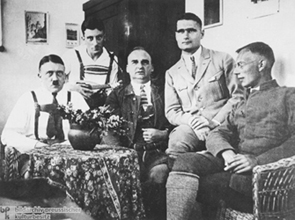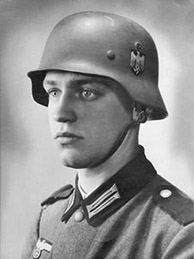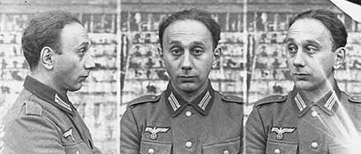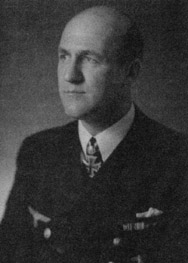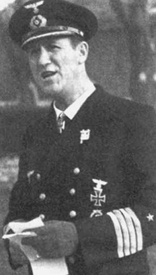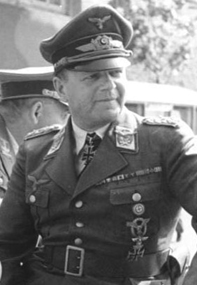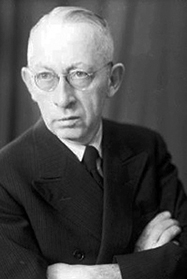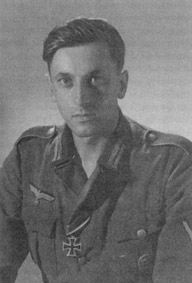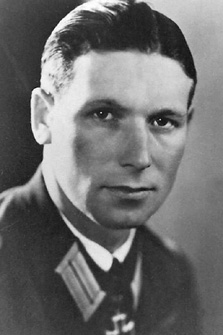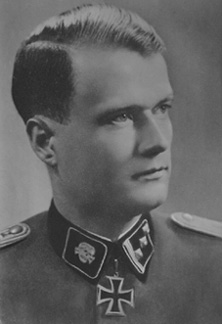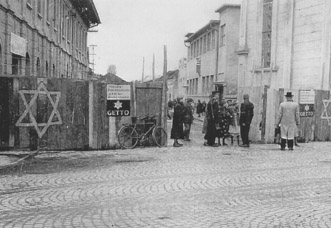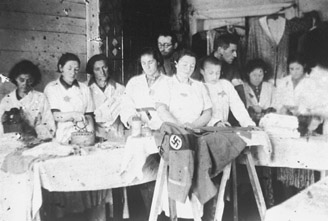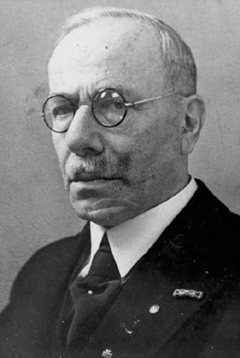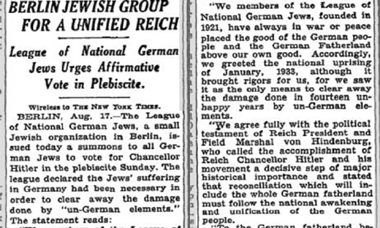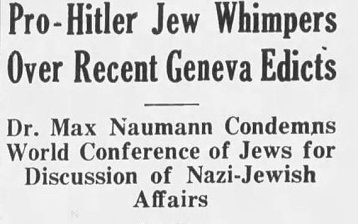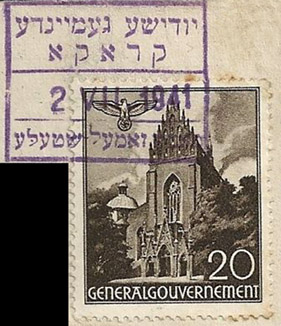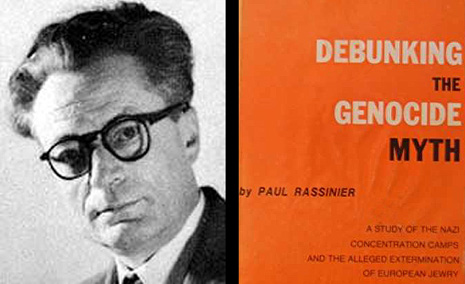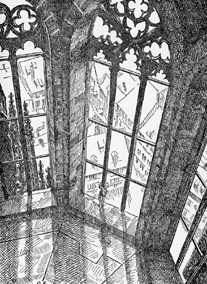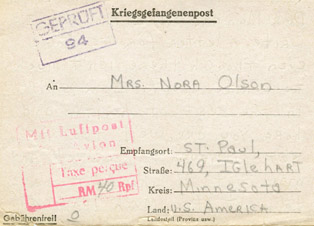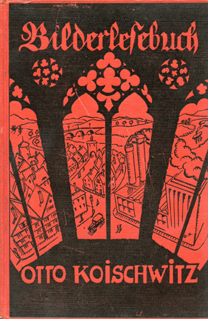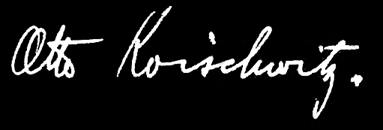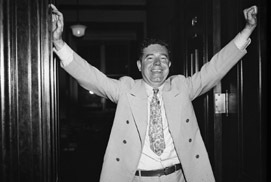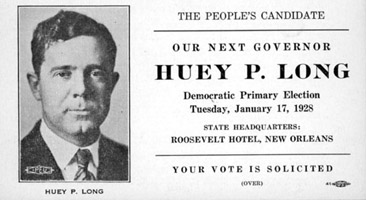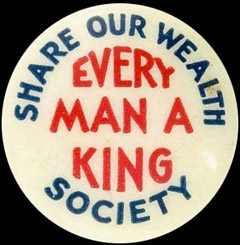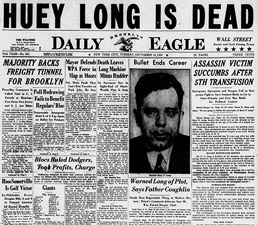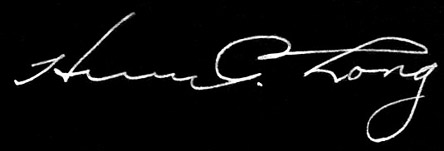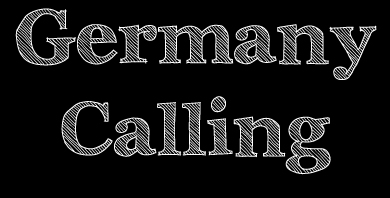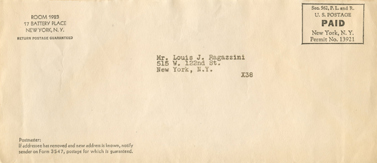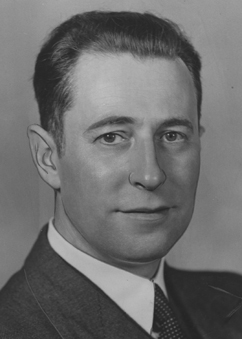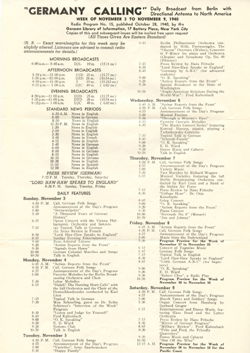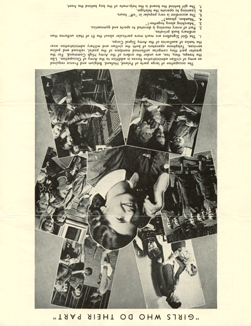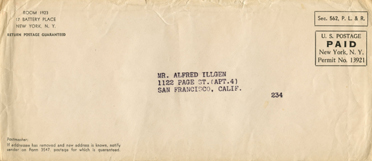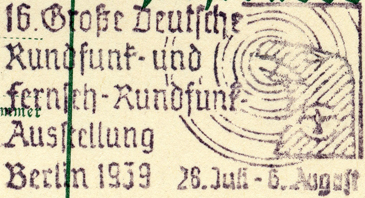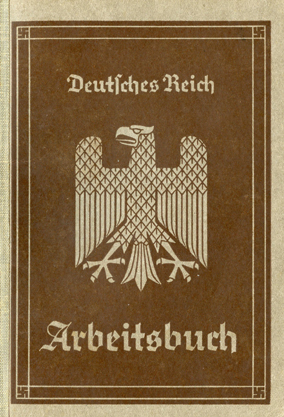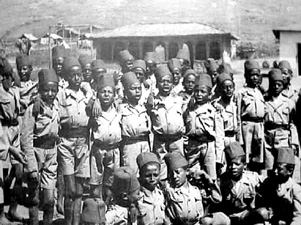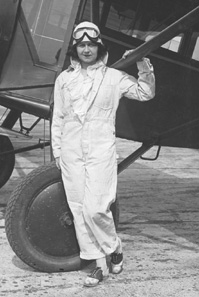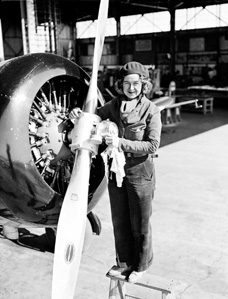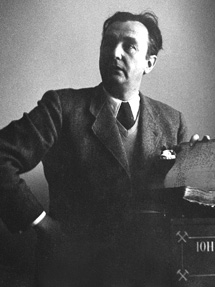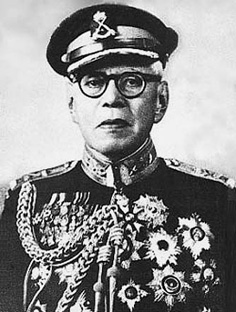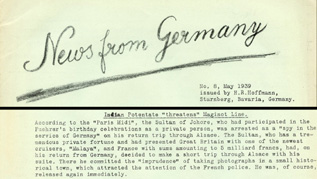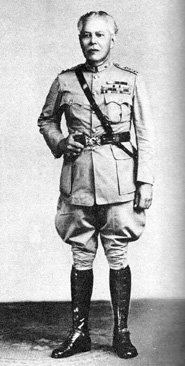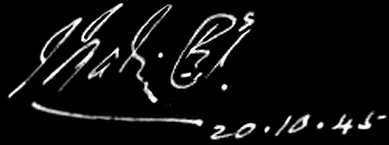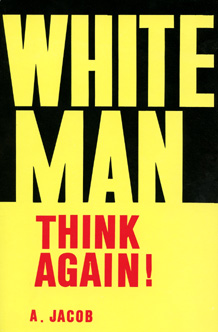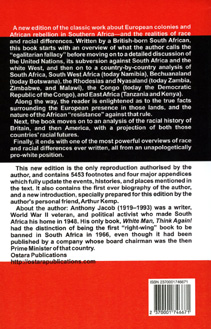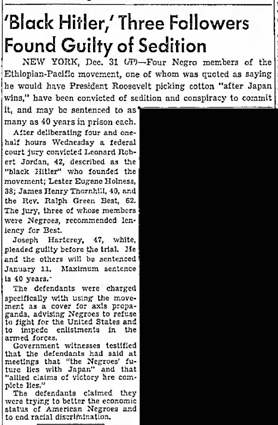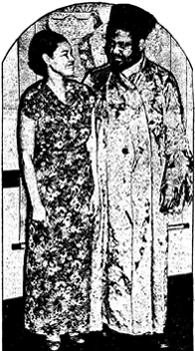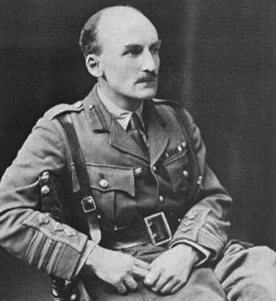
[Above: 'Wir alle sind Soldaten' = 'We are all Soldiers' (primitive late war graphic)]
Page twenty-one. We'll start this with one of the strangest, unexpected profiles: Jews fighting for the Third Reich. If you don't already know, you are in for a mind blowing ride. Yes, there were thousands of Jews, around 150,000 that fought for Adolf Hitler. But I thought we were told they were all in concentration camps and being exterminated? More proof their narrative is bullshit. Wanna see more proof that our masters lied to us? Check out this German phone book from 1942/1943! Thousands of Jews listed, tons of businesses and other services ran by Jews. In BERLIN -- the capital of the Reich. Erich, a print assistant for the widely famous Der Stürmer newspaper, ran by Julius Streicher, stated in a 1988 interview:
'Again not all Jews were removed; if they served the Reich or were nonpolitical, or married to a Christian, they were left alone.'
The rabbit hole just gets deeper and deeper doesn't it? It's all kind of hard to swallow after everything we've learned isn't it? So where is the truth? Why did they lie to us and lump all of the Jews into one giant pile of victims? Money, which they still get from Germany -- 75 years later, and counting!!! Sympathy. "Oh those poor, poor Jews..." The eternal victims. But what about that 150,000 that fought for Germany during WWII? I'm sure the commies and the Americans treated them badly and hurt their feelings. I think they should be getting payments too.
But the lies go much deeper. Jews were claiming the six million number as early as 1916. "Give us money now or six million Jews will starve." Check these out and fall deeper into the rabbit hole...
There were 150,000 'Nazi' Jews who fought for the Third Reich during WWII, including two generals, eight lieutenant generals, five major generals, 23 colonels and many of them no doubt giving their lives in combat. Why did they hide this from the world? Why were there a ton of Jewish businesses in 1943 in Berlin [see phone book above]? Of course, it's because it wouldn't fit their narrative of the poor defensless victim.
Bryan Rigg, from Cambridge University, has uncovered seventeen Jews who were awarded the Knight's Cross, Germany's highest military honor. Rigg also interviewed the former West German Chancellor, Helmut Schmidt, who had been an officer in the Luftwaffe even though he had a Jewish grandfather. Rigg had documented 1,200 cases and conducted more than 300 interviews of soldiers or their relatives. He uncovereed 30,000 documents and detailed the Jewish ancestry of two field marshals, 10 generals, 14 colonels and 30 majors.
'The revelation that Germans of Jewish blood, knowing the Nazi regime for what it was, served Hitler as uniformed members of his armed forces must come as a profound shock. It will surprise even professional historians of the Nazi years.'
[Above: Some recent works. More and more information is coming to the light revealing more of their lies]
In a 1987 phone interview Herbert Axster, Chief of Staff of the V2 rocket program and later a target of Operation Paperclip, revealed more shocking details:
'Something else they won't teach you is that we had Jews working for us as well. They loved their country and ignored the politics and in turn were left alone. Even the SS knew of these things and let it slide.' [read the interview here]
Why would Jews work on German secret weapon projects? Because these Jewish men knew what everyone else knew, National Socialist Germany was not the place that the victors painted it as.
In one of the more shocking hidden truths, the brave French Waffen-SS assault brigade Charlemagne, who stand out in the history of WWII as the indomitable giants who were amongst the last defenders of Adolf Hitler and the Reichstag, the author David Littlejohn notes:
'Of the volunteers themselves, some of the "Frenchmen" were from Indo-China (now Vietnam) and Laos, and there were even, incredible to say, some Jews (who had volunteered for the German para-military forces in occupied France [...])...'
Even more surprising, in a 1989 interview, Dirlewanger Brigade veteran Karl-Heinz had this to say:
'Later we even had concentration camp inmates join us... the camps were not what they claimed, a couple men even claimed to be Jews...'
Wait, Jews in Dirlewanger? One of the most notorious 'anti-Jewish' armed groups of the war had Jewish members? Or at the very least men who claimed Jewish ancestry. Why would anyone lie about such a thing knowing Jews were supposedly being killed all over the place? Let's see what else Karl Heinz had to say:
'My first combat action came a little later. We had to guard over the many Jewish areas, which was boring. We even had time to play with the kids, and meet the girls, even though we had orders not to make friends, as we could give away vital information. I met a Jewish girl my age, who worked making cheese, she would share with me, and I would give her chocolate and cigarettes.'
This doesn't sound like the history we've been taught does it? Men from the murderous, monstrous, and all-round evil Dirlewanger playing with Jewish children and befriending and trading with Jewish girls? WWII has to be the most lied about topic in the history of mankind. The rabbit hole is deep indeed my friends.
Below are just a few of the documented men with Jewish blood who fought for the Third Reich...
[Below: Emil Maurice, half Jewish, one of the Old Fighters who was beside Adolf Hitler during the Putsch. He was also the first personal driver of Adolf Hitler, not to mention an early member of the SS, and perhaps most importantly, a member of the Personal Guard of Adolf Hitler, the Stabswache. In 1923 he was imprisoned in Landsberg with Hitler for the failed Putsch. Note that in this picture he wears the highly coveted Blood Order medal, for those who participated in the 1923 Putsch. After the war the Allies sentenced him to four years in slave labor camp.]
[Below: The most prestigious award in the Third Reich, the Blood Order medal.]
[Below: Emil Maurice, next to Hitler, in Landsberg, 1924.]
[Below: Emil Maurice and Adolf Hitler.]
[Below: In a 1993 interview Knight's Cross winner and Battalion Commander Eberhard Heder from 5. SS-Panzer Division 'Wiking', had this to say about Jews and Emil Maurice:
[Below: Werner Goldberg, who was half-Jewish, serving in the Wehrmacht and took part in the invasion of Poland and earned the Iron Cross.
[Below: Horst Geitner, a half-Jew who risked his life fighting for the Third Reich, was awarded both the Iron Cross Second Class and the Silver Wound Badge. According to Alexander Historical Auctions:
[Below: Anton Mayer was a half-Jewish soldier who earned the Iron Cross and a wound badge.]
[Below: Admiral Bernhard Rogge, quarter Jewish, was awarded Germany's highest medal -- the Knight's Cross of the Iron Cross plus the additional coveted oak leaves (not to mention both the Iron Cross 1st class and 2nd class). He was also awarded a samurai sword from the emperor of Japan.]
[Below: Admiral Bernhard Rogge.]
[Below: Admiral Bernhard Rogge.]
[Below: Half-Jewish Commander Paul Ascher, Admiral Lütjens's first staff officer on the battleship Bismarck. He was awarded the Iron Cross 1st class and 2nd class, plus the War Service Cross 2nd Class.]
[Below: Half-Jewish General Johannes Zukertort.]
[Below: Colonel Walter H. Hollaender was awarded the Knight's Cross of the Iron Cross (plus the Iron Cross 1st and 2nd class) and the German Cross in Gold. Additionally, he was awarded the Close Combat Badge. He was also a half-Jew.]
[Below: Jewish Luftwaffe General Helmut Wilberg was awarded the Iron Cross 1st and 2nd class plus several other medals.]
[Below: A half-Jewish Field Marshal named Erhard Milch. He was a personal friend of Hermann Goering. He joined the National Socialist party on April 1, 1929. He was awarded the Knight's Cross of the Iron Cross on May 4, 1940. After Milch was promoted to Field Marshal he was also put in charge of all aircraft production. At the end of the war, after remaining faithful and fighting until the last moments, he was captured by Allied forces on the Baltic coast on May 4, 1945. Upon surrendering, he presented his coveted Field Marshal baton to the British Brigadier commando Derek Mills-Roberts, who cowardly broke the baton over Milch's head in a savage beating! A criminal act, not to mention despicable, but typical of the Allied code of conduct. Many, many soldiers were simply murdered upon surrendering and buried in mass graves. Many more were murdered in P.O.W. 'camps' (open fields with no shelter or food) or concentration camps. Another favorite of the Allies was to crush the testicles of their prisoners. I shit you not. Look it up for yourself. Milch was imprisoned for 'war crimes' in Landsberg, and was released almost a decade later in 1954.]
[Below: Field Marshal Erhard Milch.]
[Below: Field Marshal Erhard Milch.]
[Below: The full picture of Field Marshal Erhard Milch with Reich Minister of Armaments and Munitions Albert Speer. Note Milch is holding his Field Marshal's baton in his lap.]
[Below: Field Marshal Erhard Milch (left) with General Wolfram von Richthofen (cousin of the famous Red Baron). Richthofen was a true warrior and genius of battle, one of Hitler's favorites, he was the youngest officer to be promoted to the rank of field marshal, other than Göring. Von Richthofen was an open admirer of Hitler and rightly saw him as a genius without peer. Richthofen was responsible for some of the greatest military victories of Germany and the Axis. He participated in nearly every major battle, going all the way back to Germany's Condor Legion in Spain. He was a visionary, understanding air warfare like no other, and more importantly, he was driven and unstoppable. A pioneer and a brilliant tactician, he was truly one of Germany's greatest sons. During his time at the Technical Research Office Richthofen was the one who issued the contracts that led to the development of the V-1 and V-2 cruise missiles! These revolutionary orders allowed for the development of German jet engines. Loyal till the very end, he was only stopped by a brain tumor at the end of the war.]
[Below: Click on the image to see a personal photo album given to Field Marshal Erhard Milch in 1941 by his Hauptmann.]
• Click here to see more pictures of Field Marshal Erhard Milch
• Click here to see pictures of documents and awards signed by Field Marshal Erhard Milch
[Below: General Gotthard Heinrici was awarded the Knight's Cross of the Iron Cross with Oak Leaves and Swords, an incredible achievement. Heinrici was a highly respected tactician by Adolf Hitler himself. As proof he was made commander-in-chief of the last remaining forces of Army Group Vistula (final remnants of Army Group Center) in front of Berlin in April 1945. That aside, Heinrici's wife Gertrude was half Jewish.]
[Below: Gotthard Heinrici (left) with Adolf Hitler, 1937.]
[Below: Half-Jew, Hans Eppinger, a doctor and medical researcher of the SS. He worked at the Dachau concentration camp.]
[Below: Hans Eppinger, circa 1940.]
[Below: Born to Jewish parents, meet Lieutenant Paul-Ludwig Hirschfeld. Holder of the War Merit Cross Second Class with Swords, Wound Badge and a Sharp-Shooter Badge.]
[Below: Half-Jew Ernst Prager and Hella Koberger during their wedding in October 1941. He earned the Iron Cross 1st and 2nd Class and a Golden Wound Badge.]
[Below: Ernst Prager after surviving the hell of the Eastern Front, where he was shot a whopping seven times.]
[Below: Half-Jewish Lieutenant Colonel Ernst Bloch. As you can see he bares a disfiguring scar on his face from battle. He earned Iron Cross 1st and 2nd Class, Wound Badge, War Service Cross 2nd Class and war Service Cross 1st Class.]
[Below: Half-Jewish Obergefreiter Dieter Fischer. He earned the Iron Cross 2nd Class, Wound Badge, Assault Badge and the Eastern Campaign Medal 1941-1942.]
[Below: Half Jew Klaus-Peter Scholz while in the RAD labor service, with his mother Olga, 1938.]
[Below: Half-Jew Unteroffizier Karl-Arnd Techel, who was awarded the Iron Cross 1st Class and 2nd Class, Paratrooper Assault Badge and the Wound Badge.]
[Below: Half-Jewish Helmut Krüger, 1940. He won the Iron Cross 2nd Class and the Wound Badge.]
[Below: Half-Jewish Friedrich Wilhelm Schlesinger, 1942. He won the Iron Cross 2nd Class, Wound Badge, Assault Badge in Silver and the Eastern Campaign Medal 1941-1942.]
[Below: The cold grave of half-Jew Lieutenant Joachim Sonntag on the Eastern Front, November 1942.]
[Below: Quarter-Jewish Captain Horst von Oppenfeld. He won the Iron Cross 1st and 2nd Class, the Panzer Assault Badge in Silver and the Wound Badge.]
[Below: Half-Jew Hanz Meissinger, Spring 1940.]
[Below: Quarter-Jew Oberbaurat Franz Mendelssohn (far right). He joined the National Socialist German Worker's Party in 1934. He's pictured here at the wedding of his daughter.]
[Below: Half-Jew Unteroffizier Günther Scheffler, who won the Iron Cross 1st and 2nd Class, a Campaign Medal and a Wound Badge.]
[Below: Panzer Abwehr Regiment 23 at Potsdam Sans Souci Palace, ready to take their oath to Adolf Hitler, summer 1939. Here is the Nachrichten (communications) platoon. Three of the men here are half-Jews: Karl-Heinz Scheffler (middle row, 4th from right), Rudolf Sachs (front row, 3rd from right) and Hannes Bergius (front row, far right).]
[Below: A Jewish man in National Socialist (NSDAP) uniform.]
[Below: Not all is as it seems. The 'historians' seem to have left out a 'few' interesting facts. Case in point, where do you think this picture was taken? Somewhere on the streets of Germany, you say? Berlin 1930s? Crowds of Germans ready to meet Adolf Hitler? No, no and no. The crowd, Jewish residents of Litzmannstadt, screamed 'Herzlich willkommen' (heartfelt welcome). Litzmannstadt was a Jewish ghetto in Poland. This picture shows German soldiers as they entered the city...]
In a 1990 interview with a 'Willi', a German veteran from the 44th Infantry Division Reichsgrenadier Division 'Hoch-und Deutschmeister', the old soldier reveals:
'We moved on into a city called Krakau and here was another strange incident, Jews came to us begging for help to stop attacks on them.
In a 1988 interview with Heinz-Peter Wack, winner of the German Cross in Gold and officer in the Pioneer Battalion 132:
'There were attacks on Jews as well by the Poles, which the army had to stop. Can you imagine? You would not believe that today but we protected Jews.'
In a 1983 interview with Knight's Cross winner and veteran of the Battle of Kursk, Major Hans Drexler, he states:
'I was part of army group center; I will tell you what I saw. The first large city we came into was Bialystok [the largest city in northeastern Poland],
We stopped in the city to settle things down, the mobs were enraged, the SS and police had to arrest many to stop it.
Later on the Soviets emptied the prisons, and the former prisoners went on a rampage of killing those who had turned them in.
This is what the mob told us, and it was a day of revenge against those who had committed crimes or aided in crimes against the people.
[Below: Major Hans Drexler.]
In another interview, done with Luftwaffe assistant (Luftwaffehelferin) Elizabeth Lubes in 1999, she comments on her experience with Jews in Lviv in October 1941:
'The first thing I saw when walking around the city center was armed Jews with armbands. We were told they were on our side and protecting the city from criminals within their ranks.
'...and I understand that when the Bolsheviks retreated, many Jews died in pogroms before German forces stopped it and restored order.
In yet another interview, this time with Albert Stenwedel, Knight's Cross winner and Battalion Commander of the 13. SS-Gebirgs Division Handschar, done in 1993, he states:
'I know we are getting blamed for killings of Jews, which we never did. I remember in the Baltic States after liberation we knew local militias killed many Jews whom they blamed for helping the Soviets.
[Below: Albert Stenwedel.]
And still another interview, done in 1988 with the great SS-Sturmbannführer Walter Reder, who served in the SS Division Totenkopf and was Battalion Commander of the 16. SS-Panzergrenadier Division 'Reichsführer-SS'.
Reder was also a winner of the Knight's Cross and German Cross in Gold, amongst a plethora of other medals. Reder spent decades behind bars after the war for alleged 'war crimes', but said this about Jews:
'There were many Jews in Poland also, whom I will note were very kind to us.
[Below: Walter Reder.]
• Jews were given authority to handle their own people, in ghettos, camps and elsewhere. Below are a few examples of Jewish people in authority positions.
[Below: An entrance to a Jewish ghetto in Poland. No German soldiers or guards in sight. Were the ghettos to protect Jews?]
[Below: Wait, a ghetto trolley?]
[Below: A large group of Jewish ghetto police]
[Below: Jewish police force in the Lodz, Poland ghetto.]
[Below: Two Jewish police officers in the Warsaw, Poland ghetto.]
[Below: Jewish police at attention, May 1941.]
[Below: A Jewish officer at the Salaspils Police Prison and Re-Education Through Labor Camp (Polizeigefängnis und Arbeitserziehungslager) in Latvia (also known as camp Kurtenhof).]
[Below: Jewish women sewing NSDAP uniforms. Jews performed many tasks during WWII, from mundane everyday jobs to highly technical jobs like working in V1/V2 rocket plants!]
[Below: As all people, Jews were an important workforce for the Third Reich.]
Very strange to your ears, isn't it? Jews working for National Socialist Germany? We've been jammed with so much propaganda and so many lies that our brains can barely even consider the possibility. Can we comprehend that countless German Jews were equal fodder for the great Judeo-American murder machine? Can we understand that even lowly Jews are victims of the great lies of WWII? Their house of cards -- their empire of skulls and oceans of blood -- depend on their lies being universally believed. That includes Jews themselves.
In a 1989 interview with Günther Ortmann, Battalion Commander of the SS-Police Division, he states:
'There were countless Jews who remained in Reich territory who left politics alone and in turn were left alone. Berlin had a large Jewish population even at war's end, and Jews fought for the Reich in all capacities as well. They were not our enemy, only the left radicals were.'
Not all Jews were Zionists or supported the anti-German campaigns. Here are two which didn't conform:
[Below: Max Naumann (January 12, 1875 – May 18, 1939) was the founder of 'Verband nationaldeutscher Juden' (League of National German Jews). Naumann was an infantry commander in the Bavarian Army during World War I where he earned the Iron Cross (1st and 2nd Class).]
[Below: Newspaper artile regarding Max Naumann.]
[Below: Newspaper artile regarding Max Naumann.]
[Below: Newspaper artile regarding Max Naumann.]
[Below: Newspaper artile regarding Max Naumann.]
[Below: Hans-Joachim Schoeps (January 30, 1909 - July 8, 1980) was a Jewish-German professor historian of religion and religious philosophy. He was the leader of 'Der deutsche Vortrupp' (The German Vanguard), a group of 150 Jewish students who were Jewish-German followers of Hitler. They were anti-Zionists and often referred to as "Nazi Jews". Schoeps wished to integrate Jewish-Germans into the Nazi Reich.]
[Below: A postage stamp from German occupied Poland (General Government) from 1941 showing a cancel in Hebrew from the Jewish community in Krakow.]
[Below: Here's another interesting tidbit. If you look up the RZM government contract 'M1/42' you will find that this zinc NSDAP party badge is made by a company named 'Kerbach & Israel' from Dresden. A Jewish company. A Jewish company which produced 'Nazi' party membership badges. Hmm... something sounds strange, doesn't it? It is claimed that this company was later 'taken over' by the government, but if that is the case, then why still use the name 'Israel'?]
[Below: The beloved and famed National Socialist hero, Léon Degrelle, whom Adolf Hitler had personally told 'If I had a son, I'd want him to be like you', had no hatred for the Jewish race in particular. Here's a line from Degrelle's granddaughter Elena Balaguer Degrelle, who published a letter on April 12th 1994 in the newspaper El Mundo:
'Would you be interested to know that he (Léon Degrelle) had Jewish coworkers on his newspapers and in his party, and one of them became a rexist deputy?'
[As quoted in 'Léon Degrelle in Exile (1945 - 1994)', pg. 484, ©2022 José Luis Jerez Riesco, Translated by Jason Rogers, Antelope Hill Publishing (originally published in Spanish in 2009).]
[Below: Interesting words from Hermann Göring, shortly before his suicide, as quoted by American psychologist Gustave Gilbert: '...that he had never been anti-Semitic himself, had not believed these atrocities, and that several Jews had offered to testify on his behalf.' This was by far not unique. In fact, many Jews came forward to be character witnesses for the accused 'Nazis'. Many even helped Germans after the war that had had everything taken from them. A number of Jewish former concentration camp inmates even came forward to protest the Allied lies that they were death camps. Some even wrote books trying to set the record straight. These Jews found themselves as much an enemy to the powers-that-be as the 'Nazis' themselves. The fact of the matter is, the tyrants do not care if you are a Nazi or a commmunist, a democrat or a republican, a black, a woman or a man, or even a Jew. They will destroy you equally if you try to tell the truth.]
A 1991 interview with Berthold H., a police officer in Danzig and veteran of the 4th SS Police Division, had this to say:
'The Jews were in small enclaves throughout Poland, mostly in the east. In 1939, they were left completely alone. I remember going through a small hamlet close to Warsaw, our truck broke down, and the local rabbi came out with his large family to see if they could help, and encouraged others to come out. They provided us with lunch as we waited for repairs. They looked poor and ragged, I remember, but were very friendly and knew they had nothing to fear from us. There were several incidences where Poles attacked Jews and we had to intervene to stop them. During the war with Russia, we really saw this, where entire hamlets were razed by Polish bandits, killing every last Jew. This was due to the reign of terror of the Bolsheviks in Poland, who were aided by Jews many times.
Whenever we went into a town, the Poles wanted Jews removed, and Jews came to us for protection. It put us in a dilemma.'
[Below: Paul Rassinier (March 18, 1906 – July 28, 1967) is a prime example of a 'wrench in their machine'. He was a communist and a member of the 'French resistance' AND was an inmate in Buchenwald and Mittelbau-Dora concentration camps. After the war he wrote books and spoke out against the Allies' lies of death camps. He spoke with a weighty authority, not only was he a a fervent anti-'Nazi', HE WAS THERE. The enemies of truth called him 'the father of Holocaust denial'. The dark forces of the world suppressed his personal story of truth and did everything they could to stifle Rassinier himself.]
Then there is this: Élie de Rothschild. A Jew if there ever was one. His son was even a commander in the Israeli Navy. Digest the quote below, it speaks volumes...
'He and his brother served as officers in a cavalry regiment—the Anciens 11èmes Cuirassiers—when Nazi Germany invaded France in 1940. Both were captured by the Nazis close to the Belgian border during World War II. Élie was taken to the prisoner of war camp Oflag X-B at Nienberg near Hamburg. After being discovered planning to escape, he was taken to Oflag IV-C at Colditz Castle, then to Oflag X-C at Lübeck, one of the toughest POW camps. There, he was reunited with his brother. Despite being persons of Jewish descent, both were treated by the Wehrmacht as captured officers. He was released in early 1944. Élie later recounted that, despite the harsh condition of the prison, he had been treated well and respectfully throughout.
While in Colditz, Élie had written to his childhood sweetheart Baroness Liliane Fould-Springer and asked her to marry him, which they did by proxy by 1942—Élie being allowed to take his marriage vows while imprisoned. Her mother thought her foolish to take on the Rothschild name with the Nazis in control of France. However, they were not troubled during the Nazi occupation.'
The bottom line is Hitler and the National Socialists were against criminals and any dangerous, divisive or degenerate forces within Germany, any threat to the people needed to be neutralized. If that were a Jew a or a Christian, an Aryan or an alien, you would be arrested and punished and given a chance for rehabilitation. That's no different than most places in the world, minus the rehabilitation. The Americas are full of dungeons, where one is tortured and cruelty is commonplace.
As hard as it may be for a brainwashed mind to consider, in Hitler's Germany, people of all races and religions joined the international crusade of National Socialism to destroy communism.
And yes, that also means Jews.
Prisoners were put into work programs, producing badly needed goods for a vast variety of products, but still Germany suffered a severe manpower shortage. Workers were hired and shipped into Germany from great distances. There they were highly valued, taught skills and were paid for their labor. Some prisoners and foreign workers were even used in rocket factories.
• Click here to see more pictures of Jewish ghetto police
[Above: Max Oscar Otto Koischwitz]
• Max Otto Koischwitz (February 19, 1902 – August 31, 1944), sometimes called 'Mr. OK' (from his initials), or Doctor Anders, was an American citizen of German origin. Like the many other American patriots, Koischwitz recognized WWII for what it was - German resistance to Anglo-Jewish world control and finance. He recognized communism as the threat it was, which was soon to swallow half of Europe.
Military service was deep in Koischwitz's blood. His ancestors had a rich history of patriotism and sacrifice in Germany and Prussia.
Koischwitz was a gifted and sharply intelligent man. In 1920 he completed his secondary education in Berlin, four years later he graduated from the University of Berlin in 1924, after which he immigrated to the United States and later became a citizen on March 29, 1935.
In the USA Koischwitz blossomed. First he taught German at Columbia University and later became a professor of German Literature at Hunter College, New York City.
It is very interesting to note that originally he did not support Adolf Hitler and was rather 'anti-Nazi' in fact. But as the 1930s progressed he saw the miracles that Adolf Hitler was doing and staunchly changed his mind. He was an open supporter of National Socialism.
[Above: An example of Koischwitz's artistic talent taken from his book Die Bilderfibel, 1937.]
[Above: Opening page of Die Bilderfibel - art done by Koischwitz.]
[Above: Taken from his Bilderlefebuch - art done by Koischwitz, 1933.]
He would soon come crashing head first into the dark forces that were swallowing America's soul. In the Autumn of 1935 Hunter College forced Koischwitz to take a leave of absence after charging him with the high crime of 'anti-semitism'. Yes our man Otto was telling it like it is in his college lectures.
In January 1940 he immediately resigned from Hunter College. So this was the 'Land of the Free' eh? Otto had a lot to learn, but he was an excellent student. Disgusted, but far from beaten, he returned to Germany.
Just a few months later, in the spring of 1940, Koischwitz got a new job as a program director in the U.S.A. Zone at the Reichs-Rundfunk-Gesellschaft (German State Radio). Highly intelligent and equally clever, Koizchwitz directed his radio show toward
college students and German-Americans in the USA. His show gave him a chance to talk about his many interests, from philosophy, literature, drama, politics and music. His enemies claimed that his broadcasts were laden with anti-Jewish, anti-British, anti-communist and anti-Roosevelt sentiments. And they were right! Proudly so! He has been described as:
'...anti-Semitic and a heart felt supporter of National Socialism...'
While in Berlin Koischwitz met up with one of his former students, Mildred Gillars. Yep, Axis Sally herself. Gillars was teaching English at the time, but destiny called. Koischwitz offered her a job on the radio. And she took it.
[Above: Mildred Gillars]
The both of them became a force to be reckoned with. Koischwitz was a driving force. A man dedicated to waking up his fellow man from the mental dungeons they were born into.
It was inevitable the two would fall in love. Together they ruled the airwaves. American soldiers loved listening to the pair, especially during the 'Home Sweet Home Hour', aimed especially at the Allied forces in North Africa.
Koischwitz gave everything he could to the cause. He even found time to edit a magazine called 'The Overseas Kid' for American POWs. This did not go unnoticed, in September 1943 he was made the head of the USA Zone. But Koischwitz wanted more. He was a man driven, possessed with boundless energy for the fight.
In October 1943 he and Gillars were given permission to tour POW camps. In what proved to be an extremely popular segment, the two interviewed American POWs and recorded and broadcasted messages to their loved ones back home. The American propaganda machine likes to say that Koischwitz edited the interviews to make the POWs sound happy. They also like to say the American POWs didn't have enough food and supplies. But I've read many stacks of American POW mail written to loved ones at home. They sound about as happy (and bored) as a prisoner could be. Anyway, here is a sample of American POW mail. But maybe the Germans put guns to their heads and told them what to write. Yeah sure.
[Above:
Koischwitz and Gillars continued to visit POW camps, even after D-Day (June 6, 1944), they toured hospitals and POW camps while staying in Chartes (famous for the Notre Dame Cathedral) and Paris.
Always the creative one, Koischwitz experimented with writing and producing sketches and plays with Gillars in the lead. On May 11, 1944 they performed the 'Vision of Invasion', a little over three weeks before the D-Day invasion.
[Above: Koischwitz at Hunter College, New York City.]
Koischwitz had a fire burning within him that nothing could extinguish. Even as the war drew closer to its inevitable end it did not sway him, in fact he only grew more dedicated. He had broadcast for nearly the entire war. Nothing could stop him. Not the monstrous Allies. Not death. He breathes in our words. Here his deeds are writ in digital stone.
It is reported that Koischwitz died in Berlin's Spandau Hospital of tuberculosis and heart failure on August 31, 1944. By then Berlin was in ruins, a shell of its once beautiful self. But the real beauty was just beneath the burnt wreckage and unburied bodies. Beneath the terrible veneer of Allied war crimes shined indomitable human beings. Who no bomb or bullet could stop. The Otto Koischwitzes. Who, despite all, fought on.
Of course, we will never really know what happened to Koischwitz. After all, when he died he was captured and in communists hands. I think it is very likely that he could have been murdered, along with the millions of other Germans and others who were massacred after the war by the victorious Allies. Koischwitz wouldn't have made a good prisoner. He wouldn't stay silent and watch innocent women and children be raped and murdered. As Adolf Hitler said:
'There are two ways to judge a man: by the woman he marries and the way he dies.'
I know in my heart Koischwitz would have died a hero. He certainly lived as one.
The United States placed charges of treason on Koischwitz and others. The charges were formally withdrawn by the Department of Justice due to lack of evidence on October 27, 1947.
[Above: This graphic is taken from a period writing called 'American Traitors Abroad'. It profiled most of the American broadcasters who worked for the Third Reich.]
During the 1930s and early 1940s Koischwitz published a handful of books, beginning with:
[Above: (left) Koischwitz wrote Deutsche Fibel (German Primer) in 1932, F.S. Crofts, & Co., 131 pgs. This is an ultra rare autographed first edition. (right) SECOND EDITION. F.S. Crofts, & Co., 1932, 131 pgs. Click to see more.]
[Above: In 1933 Koischwitz wrote Bilderlefebuch (Picture Reading Book), F.S. Crofts & Co., 1933 - 132 pg.]
[Above: Introduction to Scientific German, F.S. Crofts & Co., 1936 - 155 pgs.]
[Above: (right) Reise in die Literatur (Journey into Literature), George G. Harrap & Company, 1937 - 195 pgs. (left) J.B. Lippincott Company, 1937 - 195 pgs.]
[Above: (right) Die Bilderfibel (Picture Primer) was released in 1937 and contains a combination of Koischwitz's works, Deutsch Fibel and Bilderlesebuch, Appleton-Century-Crofts, - 122 pgs. (left) F.S. Crofts, & Co. edition, 1937 - 122 pgs., autographed.)]
[Above: Farmer Hildebrand, Winkler and Burg, 1942 - 141 pgs.]
A few excerpts from his broadcasts follow:
'The world of today is divided into two
camps. On the one side, Bolshevism. On the
other, the defenders of civilization. Why is
America still in the wrong camp?
And do you believe that the defenses of
Europe are only improvised, or that you
could outnumber the mighty Axis armies
in Europe like another Afrika Korps? The
only territory that any of the American
soldiers would ever occupy in Europe will
be the six feet of sod in one of the military
graveyards in which we shall bury the remains of any and every man who attempts
to force his way into Europe.
The camp where the American boys are
at present is the most beautifully located
prisoner-of-war camp I've ever seen, and
I have seen many of them... One of the
German officers who took me through the
camp complained with a smile that the
Americans didn't behave exactly soldier-like. Now that struck me as very funny,
because I heard it before, over the London
wireless. The BBC affirmed that their American friends lacked discipline. The Americans
in Africa, the radio related, asked too many
questions. They lack the traditions of their
British cousins...'
[Above: Otto Koischwitz.]
[Above: Otto Koischwitz's signature.]
On March 15th, 1946 Mildred Gillars was arrested and her only request was to take a picture of Koischwitz with her.
[Above: Huey Long -- lovingly dubbed 'Lousiana's Hitler' by the press.]
• Huey Pierce Long Jr. (August 30, 1893 – September 10, 1935), was an extremely important and equally interesting American politician with the nickname 'The Kingfish'. He was the 40th governor of Louisiana from 1928 to 1932 and a member of the United States Senate from 1932-1935.
During the Great Depression Huey Long grew incredibly popular. He didn't like President Roosevelt's 'New Deal' and he spoke out against it. His fiery personality gained him many dedicated followers. He was from one of the poorest parts of Louisiana and he rose from the same poverty that so many Americans were drowning in. The people could relate with him and he became a true champion of the poor. He was a populist member of the Democratic Party and his popularity grew with his 'Share Our Wealth' program.
Long was one of nine children born into a very poor part of north-central Louisiana near a town called Winnfield, the seat of Winn Parish, and the residents felt left out and hopeless when it came to the political system. His parents opted to home school him until the age of eleven after which he entered Louisiana's public school system. He proved to be way ahead of the other students and quickly gained a reputation as a very smart child, so intelligent that he asked to skip the seventh grade and it was granted. He was even awarded a full scholarship to Louisiana State University for his debating skills... unfortunately the scholarship did not cover the textbooks he needed or a place to live and his family simply could not afford it. His calling would have to wait. This brilliant young man had to find a job and he became a traveling salesman. Certainly this experience influenced his future position in politics.
Later he finally was able to attend a few colleges and became a lawyer where he worked representing the poor. During this time Long was elected to the Louisiana Public Service Commission. He wasn't afraid to take on big corporations and he prosecuted large companies such as Standard Oil. U.S. Supreme Court Chief Justice and former president William Howard Taft is quoted as saying that Long, after a successful argument, is "the most brilliant lawyer who ever practiced" before the court. What a compliment!
For a very short period, and at the behest of his devoutly religious mother, Long attended Seminary school at Oklahoma Baptist University in September 1911. After a semester he realized that being a Baptist preacher was not for him and his true calling was the law.
In 1912 Huey Long attended the University of Oklahoma College of Law and also worked as a salesman in order to support himself. During this time he promoted a baking contest in order to sell Cottolene shortening. This would prove to be one of the most important days of Long's life. He met the love of his life, Rose McConnell. In April 1913 the two were married at the Gayosa Hotel in Memphis Tennessee. They had a daughter and two sons by 1921.
[Above: Huey Long and his wife Rose McConnell.]
Shortly after his marriage Long enrolled at another college, this time Tulane University Law School in 1914. Within one year Long felt that he was ready to successfully pass the bar and petitioned the Louisiana Supreme Court to take the test early, he did and passed. In May of 1915 he received his license to practice law.
Huey Long wasted no time and had a private practice in Winnfield in 1915. The majority of all his cases were representing poor people, mostly in workers' compensation cases.
In 1918 Long entered the race to serve on the three-seat Louisiana Railroad Commission and won. Once on the Commission, Long forced utility companies to lower their rates, ordered railroads to expand their service to include small towns, and demanded that Standard Oil quit importing Mexican crude oil and instead use more oil from Louisiana wells. He actually did the things he promised to the people while campaigning... can you imagine that?! No politician in recent memory can claim to have done the same!
That same year Huey Long invested a substantial amount of money in an oil well that struck oil. The Standard Oil Company refused any of his oil in their pipelines and Long lost his entire investment. This understandably caused Long to have a hatred towards the company for the rest of his days.
[Above: Huey Long]
The historian William Ivy Hair described Long's political message as:
' ... would be repeated until the end of his days: he was a young warrior of and for the plain people, battling the evil giants of Wall Street and their corporations; too much of America's wealth was concentrated in too few hands, and this unfairness was perpetuated by an educational system so stacked against the poor that (according to his statistics) only fourteen out of every thousand children obtained a college education. The way to begin rectifying these wrongs was to turn out of office the corrupt local flunkies of big business ... and elect instead true men of the people, such as [himself].'
In 1920, Long campaigned heavily for John M. Parker in the gubernatorial election and was instrumental in getting him elected. Unfortunately Parker refused to declare the state's oil pipelines public utilities and caused a terrible rift in his relationship with Huey Long. Long could hardly believe it when Parker allowed oil companies to assist in writing severance tax laws, led by Long's enemy, Standard Oil's legal team! He was incredibly angry with Parker, rightfully so. In 1921 Parker had the gall to attempt to have Long ousted from the commission. Thankfully he was unsuccessful. Parker was just another greedy, selfish political drone. Our government today is absolutely filled with these degenerate types.
Two years later Huey Long was the chairman of the commission. He was also the prosecutor of a case that was argued before the Supreme Court on appeal about unfair price increases by the Cumberland Telephone & Telegraph Company. He successfully argued the case and the company was forced to pay back cash refunds to thousands of customers who were overcharged. After the trial Huey Long was praised by Chief Justice William Howard Taft as, 'the most brilliant lawyer who ever practiced' before the United States Supreme Court.'.
Long didn't win the 1924 gubernatorial election, but he was undeterred and resilient and he ran again in 1928 and won!
[Above: Huey Long]
As the Governor of Louisiana, Huey Long was extremely productive. He instituted a modern highway system, along with the tallest capital building in the entire nation. Public works and social programs were on the top of his list to do, and unlike so many of the corrupt and lying politicians we are all used to, he actually did what he said he would. He was elected into the U.S. Senate in 1930, although he didn't assume his seat for two years until 1932. Long was a populist member of the Democratic Party and gained much popularity during the Great Depression. Like other great men of his time, he was very vocal critic of Roosevelt and his New Deal. He was also very vocal about the fact that Standard Oil and Wall Street orchestrated American foreign policy. He came up with an alternative in 1934, it was the Share Our Wealth program. The program was wildly popular. Here are the highlights of the program:
• Limit annual income to one million dollars each (about $12 million today)
• Limit inheritances to five million dollars each (about $60 million today)
• Guarantee every family an annual income of $2,000 (or one-third the national average)
• Free college education and vocational training
• Old-age pensions for all persons over 60
• Veterans benefits and healthcare
• A 30 hour work week
• A four week vacation for every worker
•Greater regulation of commodity production to stabilize prices
• Huey Long Speech, February 23, 1934
[Above: Share Our Wealth pin/button]
1935 saw immense popularity for Huey Long. His Share Our Wealth Society had an astounding 7.5 million members in 27,000 clubs all across the country. His office at the Senate received so many letters from supporters that he had to hire 32 typists in order to write them all back! A national poll found him to be the most attractive man in America, even ahead of the popular Tarzan actor. He was even the third most photographed man in the country, right behind Roosevelt and Charles Lindbergh.
Apparently the rulers of our corrupt world saw that people agreed with Huey's program and loved the man. He was charismatic, smart and genuine. He was ready to change the country and bring some justice to it. Roosevelt was even stealing some of Long's ideas because he knew he wouldn't be able to compete against him if he didn't, all the while publicly attacking his proposal. Roosevelt did what what the powerful people always do in this country when they feel threatened, he tried to sic the FBI and the IRS on him. He desperately tried to discredit him at every angle.
[Above: Huey Long]
As the increasingly popular Huey Long was poised to run for the 1936 presidential campaign, the dark powers in this world put a stop to that. On Sunday, September 8, 1935, Senator Huey Long was murdered at the Louisiana State Capitol in Baton Rouge. Long was at the capitol to pass a bill when he was ambushed and shot in the chest by a Jewish man named Carl Weiss. Long's bodyguards shot and killed the murderer and Weiss died instantly. Long however lived for another 31 hours, but unfortunately surgeons failed to save him. Sadly he died and was pronounced dead at 4:10 a.m. on September 10, 1935.
An incredible loss for the country, people were devastated and 200,000 people attended his funeral. He was buried at the Louisiana State Capitol, the very same capitol building that he had constructed. A statue was erected on his grave in 1940. Huey Long and Robert F. Kennedy are the only U.S. senators to ever be assassinated. He was no longer a threat to Roosevelt, who was re-elected. The same ol' same ol' ridiculously greedy, evil and selfish bastards celebrated the death of a man a million times greater than them. These evil, childlike men continued on, business as usual. Fuck the people, fuck the country, only their petty little bank accounts matter. Justice will come for the great Huey Long, one day. But alas, justice is slow. But it is certain.
[Above: September 10, 1935. One of America's greatest sons, dead.]
[Above: Huey Long monument and burial site]
'I'm for the poor man -- all poor men, black and white, they all gotta have a chance.
[Above: Huey Long's signature]
• Click here to see pictures of Huey Long
'Anti-Semitism is the word used by the Jews to designate any form of opposition to themselves,
[Above: Father Denis Fahey.]
• In the hunt for truth during and after WWII, I naturally came across the wildly popular Father Charles Coughlin. Next, and much more difficult to find, was Father Edward Curran, the so-called 'Father Coughlin of the East'. Third I've found a very special Christian fighter for truth, his name was
Father Denis Fahey, and unlike Coughlin and Curran, who seem to be largely forgotten, Father Fahey still has a very active pool of admirers and supporters. For example, his sizable body of books he wrote during his life are still in print and widely available. Numerous articles are online praising him, largely from a Catholic community, a sort of purist Catholic community. One which Fahey himself represented, which got him into trouble with the Catholic Church numerous times, much like Coughlin. While he was nowhere near as popular and well-known as Coughlin, who had millions of listeners at his height, Fahey has proven to have more lasting popularity, probabaly due to his numerous religious/political books. Unfortunately Coughlin didn't write books, instead he concentrated on his newspaper, 'Social Justice'. While the newspaper was very popular at the time, and was done extremely well, they are relatively difficult to find today. Maybe one day some good soul will compile them into a book form and Father Coughlin will have the renaissance that he deserves.
Like other members of the Church, Father Coughlin was fairly influenced by Fahey and often used references on his radio programs from Fahey's writings. In fact, Coughlin's massive organization, the National Union of Social Justice, which boasted a membership of 7.5 million people (!) and included many African Americans, distributed 350,000 copies of Fahey's 1938 book The Rulers of Russia during the 1930s, free of charge! This no doubt helped to greatly popularize Father Fahey's name and reputation. And while Fahey didn't understand National Socialism, and falsely saw it as putting race as its god, his heart was certainly in the right place.
[Above: The Rulers of Russia, 1940.]
Father Denis Fahey (July 3, 1883 – January 21, 1954) was born in Ireland. He began his journey into priesthood at the young age of seventeen, first in France, then in Rome.
In 1906 Fahey received a first-class honors degree
from the Royal University with 'the highest honors in civil and constitutional history, political economy, and general jurisprudence'
In 1910 he was ordained and also attained a Ph.D. in Philosophy from the Academy of St. Thomas Aquinas. Two years later in 1912, he received his Ph.D. in Theology from the Gregorian University.
After returning home to Ireland he was made the Director of Scholastics and Professor of Philosophy at the Irish Province of the Holy Ghost Congregation in Dublin. In an interesting twist, he served as chaplain at an internment camp in Switzerland during World War I. Multilingual, he spoke German, French, and Italian.
[Above: Father Denis Fahey at a seminary at Kimmage, circa 1950.]
Father Fahey was very active in politics and recognized communism for the threat that it was, and still is. His books warned of the dangers to his time, and to the future, if the world enemy wasn't stopped.
Who was this world enemy? Communism, freemasonry and rabbinic Judaism. The powers-that-be still attack him and his writings to this day, calling him 'deeply anti-Semitic', but this is no revelation, Father Fahey himself prided himself on being 'anti-Semitic'. In his 1953 book 'The Kingship of Christ and the Conversion of the Jewish Nation' he professed that 'every sane thinker must be an anti-Semite'. Father Fahey warned the world that the Jewish forces behind communism were a deadly threat to the world. He said: 'The real forces behind Bolshevism in Russia are Jewish forces, and Bolshevism is really an instrument in the hands of the Jews for the establishment of their Messianic kingdom.' It is an interesting fact that The Kingship of Christ and the Conversion of the Jewish Nation is the only book which Fahey had trouble publishing and getting the 'okay' from his superiors. [Athans, Coughlin–Fahey Connection, pg. 71]
[Above: The Kingship of Christ and the Conversion of the Jewish Nation, 1953.]
'Satan aims at the concentration of property in the hands of a few, either nominally in those of the State,
Aside from Fahey's books he also wrote many articles, which appeared around the world. In Canada he was translated into French by the great Adrian Arcand. He also found time to regularly write letters to friends around the globe, such as to the instrumental Brit Nesta Webster.
In the early 1940s Fahey founded the organization 'Maria Duce' (With Mary as Our Leader), its aim was to fight communism and its cultural Marxism that was infecting Ireland at a rapid pace, including the Irish Republican Army (IRA), which he recognized as a communist organization. In his 1940 book Rulers of Russia Fahey wrote that if the Irish Republican Army were to gain power the result would be that Ireland would be 'trampled under foot in another world-empire ruled from Moscow or Jerusalem'.
Maria Duce organizaed protests, petitioned politicians, organized letter campaigns and distributed written materials. The organization also had a periodical, 'Fiat' (an authoritative decree or order). Fiat was known for being fearless, naming names and keeping records of those people subverting and poisoning Ireland.
[Above: An example of FIAT. Click to see a few examples.]
Among the publications Fahey contributed to was John J. O'Kelly's Catholic Bulletin , where he contributed a twelve-part article in 1928 warning of the stark danger of Freemasonry and other secret societies. Predictably these actions drew the attention of his superiors and in 1942 the Archbishop John Charles McQuaid of Dublin wrote to Cardinal Archbishop of Armagh Joseph MacRory:
'I have been obliged to watch carefully his remarks upon the Jews. [He] will frequently err in good judgement, and this error will take the shape of excerpts from newspapers as proof of serious statements, unwise generalisations and, where Jews are concerned, remarks capable of rousing the ignorant or malevolent. In his own Congregation, Fr. Fahey is not regarded as a man of balanced judgement. He is a wretched Professor, obscure and laborious.'
Wow, I have a feeling someone was in the employ of 'someone', don't ya think? In the 1950s Archbishop McQuaid would return to attack Father Fahey's Maria Duce organization, even going so far as to say he opposed the group's association to the name of the Blessed Virgin Mary. Fahey died before replying to this attack and the group disbanded a year later. Ironically McQuaid was a former pupil of Fahey's, but apparently he didn't learn some of the most fundamental truths, which Father Fahey understood so deeply.
It's interesting that when Archbishop McQuaid wasn't vehemently defending the Jews, he had glowing things to say about Father Fahey, describing him as:
'a most exemplary priest, of deep sanctity, and a man who will very generously sacrifice his time and health to help anyone: not a small sign of genuine holiness.'
Fahey's books are not protected by copyright, leaving them in the public domain. Some of his more politically oriented books are:
• The Rulers of Russia, ©1940.
• The Kingdom of Christ and Organized Naturalism, ©1943.
• Money Manipulation and Social Order, ©1944.
• The Rulers of Russia and the Russian Farmers, ©1948.
• The Kingship of Christ and the Conversion of the Jewish Nation, ©1953.
• Secret Societies and the Kingship of Christ, ©1994.
• Waters Flowing Eastward (by Leslie Fry, edited and revised by Fahey), ©1965.
Download PDFs
-Money Manipulation and Social Order-
-The Kingship of Christ and the Conversion of the Jewish Nation-
-fahey-The Mystical Body of Christ and the Reorganization of Society-
-The War of Antichrist with the Church-
'Sometimes it is not enough for a man to die.
[Above: The Berlin radio broadcasting tower.]
[Above: A distant shot of the Berlin radio broadcasting tower.]
[Above: The eagle of the airwaves, this eagle was the symbol of Germany's radio works. They played the newest and best music, songs that Americans and British young men liked. Although the Allied authorities ordered their soldiers not to listen to German stations, they still did. In between the music were British and American radio hosts working for Germany. They went to enormous lengths to try to wake up the Allied soldiers to the truth. Some of them even went to P.O.W. camps and recorded messages from the Allied soldiers to their families. Many radios in the 1930s and 1940s could tune in to international broadcasts, so this brought many new listeners, mothers and fathers hoping their son was still alive.]
• Nearly lost to history, here is a special treat for you dear viewer. This is a publication done by the German Consulate in New York that was published bi-weekly. These were released by what was called the German Library of Information. This first publication is from August 26, 1940 and is called 'Facts in Review'. As you will read, it contains very interesting information on Britain's diabolical scheming against Scandinavia, Norway in particular.
As you will note, this issue is Vol. II. - No. 35, so this is only a glimpse of this very rare publication. You will also note, on the bottom of the picture is the page number 405. So there were A LOT of issues lost, perhaps forever.
I stumbled across these rarities in my stamp collecting duties and snatched them up instantly. While researching the various Americans who became broadcasters in Germany during the Third Reich I knew all about the radio show, 'Germany Calling', broadcast on a powerful signal from Germany and listenable in the USA. But I wasn't aware that they published information and radio schedules in the USA! I'm unsure when the publication began, but it most certainly ended when the USA was drawn into WWII. As I said, these issues are incredibly rare, and to be able to see the envelopes used to send them is a special treat, especially for us philatelists.
[Above: Facts in Review - page one (cover).]
[Above: Facts in Review - page two.]
[Above: Facts in Review envelope.]
The next mailing, for September 29 - October 5, 1940, is a radio program for 'Germany Calling' the famed 'Daily Broadcast from Berlin with Directional Antenna to North America'. This is very interesting because we get to see the work schedules of the brave men and women who left the safety of the USA to serve mankind in Germany. They knew what we know now, in 2022 and beyond, that Adolf Hitler's Germany and his worldwide allies were this planet's hope for freedom and truth. It is not treason to fight tyranny and an America which had been occupied by evil and treacherous forces. As the founders of the USA told us, it is duty.
[Above: Germany Calling - September 29 - October 5, 1940.]
[Above: Germany Calling envelope.]
First, before we get deeper into the particulars, let's look at these Americans who broadcasted for the Third Reich. In no particular order (click their names to read a profile):
Herbert John Burgman
Robert Henry Best
Douglas Chandler
Iva Toguri
Max Otto Koischwitz
Ezra Loomis Pound
Frederick W. Kaltenbach
Rita Luisa Zucca
Mildred Elizabeth Gillars
Donald Day
Edward Leo Delaney
Jane Anderson
Constance Drexel
First we see a broadcast by 'Lord Haw-Haw'. This was, of course, the famed British patriot William Joyce. Next we see a show by Fred Kaltenbach, then 'O.K. Speaking', who we know to be Max Otto Koischwitz. Kaltenbach later does a show called 'Anglo-American Relations During the World-War'. Koischwitz's 'O.K. Speaking' show is played numerous times on the schedule, I'm unsure if this is the same program rebroadcasted, or a different show each time. Later on in the schedule Koischwitz does another broadcast using his full name.
Next, we see Koischwitz and Kaltenbach do a show together called 'Jim and Johnny'. You will also note a guy named Hans Fritsche does shows on the schedule. This was one of the most famous broadcasters of National Socialist Germany. It is said every German recognized his voice. He was also the 'Ministerialdirektor at the Propagandaministerium'. After the war he was not only one of the last people in Adolf Hitler's bunker, he was also considered a 'Major Offender' by the Allies after the war.
[Above: Handsome, intelligent and charismatic, August Franz Anton Hans Fritzsche was born on April 21, 1900 and died of cancer on September 27, 1953. His commitment, diligence and servitude to the cause and to his people will never be forgotten. Click the image for more!]
The next mailing, for November 3 - November 9, 1940, is another radio program for 'Germany Calling'. We see Lord Haw-Haw again first, trying with all his might to awaken a sleeping Britain. You may notice a strange German word on the broadcast schedule 'Struwwelpeter'. This is an 1845 German children's book, it means something like 'Slovenly Peter'. Even though I've never heard of this, it is widely recognized to be one of the most popular children's book ever. It was even published in English by the world famous Mark Twain in 1935. We see that the great boxer Max Schmeling is interviewed. They like to call Schmeling a 'Nazi-racist boxer' but in reality he was a lifelong friend to the black boxer Joe Lewis. Lewis was poor later in life, but Schmeling repeatedly sent him money and was even a pallbearer at Lewis' funeral, which he also partially paid for.
On the 4th of November we see radio shows by Kaltenbach and Koischwitz, but we also see 'E.D.Ward' (a play on his name 'Edward'), which is the alias of Edward Delaney. Delaney is perhaps the most complex of all the American broadcasters. His life was as colorful and lively as anyone of his age. He was also the only broadcaster never convicted, although the USA government charged him right alongside the others. Why did he go free? Out of all of Delaney's broadcasts, they could not prove he worked for the Third Reich AFTER the entry of the USA into WWII. None of his broadcasts spoke of anything specific that could help the investigators pin down a date. Although Delaney's broadcasts were played into WWII, he claimed they were merely rebroadcasting old recordings.
This offers a lot to one's imagination. Did Delaney do this purposefully, to protect himself from vengeance of the American government should things go bad for Germany? I certainly wouldn't put it past him. Delaney was incredibly intelligent and worldly. I won't get anymore into his complex life here, since his profile will cover that.
[Above: Germany Calling - November 3 - November 9, 1940.]
[Above: Germany Calling envelope.]
This next schedule I found online, and is from April 13 - April 19, 1941. We see a new show called 'America Asks -- Germany Answers', which sounds interesting. Lord Haw-Haw is still working hard to spread the truth. We also see Kaltenbach now doing his popular 'Dear Harry' show. This was him doing a show that mimicked him talking to an old friend back in Iowa (midwest USA, seen as the heartland of America and wholesome). Its aim was to be more down-to-earth and intimate. Edward Delaney is still with us with his 'E.D. Ward' persona. There is a show called 'Listen and Judge for Yourself'. Imagine that... people using their own brains to judge something, instead of the television or media filling their heads with lies. This show proved to be way too much to ask of Americans...
[Above: Germany Calling - November 3 - November 9, 1940.]
[Above: Germany Calling - November 3 - November 9, 1940.]
[Above: Germany Calling - November 3 - November 9, 1940 (reverse side of sheet).]
This schedule begins like the others before it, starting off with Lord Haw-Haw's pleas to a deaf England. Next we read of a new broadcaster -- Jane Anderson, the 'Georgia Peach'. And then, another new name -- Paul Revere, who we know is Douglas Chandler. He was sentenced to life imprisonment, fined $10,000 and lost his U.S. citizenship for daring to speak out against the Weltenfeind (World Enemy). Kaltenbach and Koischwitz are still at it, as is Delaney. This ends with an interesting 'Girls Who Do Their Part' segment.
[Above: Germany Calling - June 15 - June 21, 1941.]
[Above: Germany Calling - June 15 - June 21, 1941.]
[Above: Germany Calling - June 15 - June 21, 1941.]
[Above: Germany Calling - June 15 - June 21, 1941.]
[Above: Germany Calling envelope.]
[Above: Postcard from Berlin-Charlottenburg postmarked on August 8, 1938. It says '15. Große Deutsche Rundfunkausstellung Berlin 1938' (15th Greater German Radio Exhibition Berlin 1938).]
[Above: Above cancel close-up.]
[Above: Nuremberg postcard postmarked August 3, 1939. it says '16. Große Deutsche Rundfunk und Fernseh Rundfunk ausstellung Berlin 1939' (16th Greater German Radio and Television Exhibition, Berlin 1939).]
[Above: Above cancel close-up.]
[Above: Rundfunk identification card.]
[Above: Work book from Hamburg issued in May 1936. This man worked at the State Theater in Harburg, a major borough in the city of Hamburg and more importantly, the Hamburg Reichs-Rundfunk (Reich Radio Broadcasting). Also of interest, he worked on the little islands of Heligoland. Click to see inside.]
[Above: Work book. Click to see inside.]
[Above: Work book. Click to see inside.]
[Above: The Berlin radio tower. Click to enlarge and see reverse.]
[Above: This document (front/reverse) is from the Zentralprogrammverwaltung (Central Program Administration) of the Reichs Rundfunk (Reich Broadcasting), from Berlin, August 22, 1944, to a Dr. Lecke. It is regarding a lecture entitled 'Vom Landw. Rechnungswesen'
(On Agricultural Accounting). They offer to pay Dr. Lecke 40 Reichsmark, plus 40 for each repeat broadcast. The reverse of the document (right) explains the rules. It is neat to see one of these, they are pretty rare. Click to enlarge.]
[Above: This is a very cool postcard that gives us a look into the Rundfunk. It says: 'Richtstrahl-Antennen des Deutschen Kurzwellensenders Berlin-Zeesen' (Directional antennas of the German shortwave transmitter Berlin-Zeesen). Next check out the reverse below. Click to enlarge.]
[Above: This postcard is a 'radio station signal check postcard commonly known as a QSL card, which is a written confirmation of a two-way radio contact between two stations or a report of a one-way reception of a signal from a broadcast station.' There are thousands of QSL postcards from various stations over the years, some people even collect them as a hobby. This was sent from Berlin to Leeds, England on August 4, 1936. The red meter mail stamp says 'Rundfunk bringt Freude ins Haus' (Radio Brings Joy to the Home). Click to enlarge.]
[Above: Meter mail stamp close-up. Click to enlarge.]
[Above: Wow, this is very interesting. I've never seen this logo before... I love discovering new things like this and showing them to you! Click to enlarge.]
• Click here to read twenty one issues of Facts in Review
• During WWII there were many diverse peoples and fighting forces from Africa on the side of the Axis. Here is a look into Abissinia, better known as Abyssinia, better known as Ethiopia...
[Above: This book says:
'Terra Paese
This 1928 book by E.H. Schrenzel has 90 illustrations and was published in Berlin in 1928 and Italy in 1935. It is described as:
'Abyssinia, to which the eyes of the world are turned today, is still largely a closed and mysterious country,
[Above: Ethiopians saluting the 'Great White Father' Mussolini, Mekelle, Ethiopia.]
[Above: Ethiopian boys of the 'Gioventù Etiopica del Littorio' (Ethiopic Youth of Littorio), late 1930s.]
[Above: Ethiopian soldiers parade past lines of civilians.]
The scholar Abba Jobir Abba Dula was the sultan of Ethiopia. He was a staunch ally of fascist Italy and was even imprisoned in the early 1930s for working with the Italians. When Italy invaded the country in 1937 they released their old ally and gave him the task of leading the country. He worked extensively with Italy and helped them hunt Allied agents with the country.
During WWII Abba Jobir recorded radio broadcasts to the Arabic-speaking world, in an attempt to educate the listeners to the Anglo-Jewish threat. In 1942, following the Italian defeat, Abba Jobir was imprisoned once more, but was later pardoned by Haile Selassie I.
[Above: Mussolini and the Sultan Abba Jobir Abba Dula at a military parade in Rome, 1938.]
[Above: Mussolini and the Sultan Abba Jobir Abba Dula at a military parade in Rome, 1938.]
[Above: Ethiopian army commander and a member of the royal family of Ethiopia Ras Seyoum Mengesha, Ras Getachew Abate, who worked with fascist Italy and Ras Kebbede Guebret meeting with Mussolini in February 1937.]
[Above: Italian troops march past a large Mussolini sign in Ethiopia.]
[Above: Italian occupation of Ethiopia using an Italian note overprinted for 'Italian East Africa', 100 Lire, 1938.]
[Above: Italian occupation of Ethiopia using an Italian note overprinted for 'Italian East Africa', 50 Lire, 1939.]
[Above: Laura Ingalls.]
• Laura Houghtaling Ingalls (December 14, 1893 – January 10, 1967) was an astounding American pilot who won the coveted Harmon Trophy (best aviatrix). But to earn her place of honor on these pages she performed even greater tasks: she risked her fame and freedom to support Adolf Hitler and National Socialist Germany. In case you're wondering why you've never heard of her, well that's why. They've all but buried her name and legacy, wishing she would be forgotten.
She was born in Brooklyn, New York, a descendant of one of the early pilgrims to America, who arrived in New Amsterdam on May 9, 1661. Educated in the best private schools, she even studied in Vienna and Paris. After graduation she studied nursing in New York. However, she decided it wasn't for her and later danced in ballet and vaudeville.
Maybe you've heard the name Laura Ingalls before? Well our aviatrix was actually a distant cousin of Little House on the Prairie's Laura Ingalls Wilder. You might remember her from her popular series of books or television series. Her books have recently been banned from some libraries for being 'racist' due to her description of American Indians (I've read her books, they were not 'racist', but a product of the time. Her mother was fearful of American Indians and her dog didn't like them. Her father also sung a 'racist' song as well). The American Library Association even went so far as renaming its Laura Ingalls Wilder Lifetime Achievement Award to the Children's Literature Legacy Award in 2018. They've actually censored parts of her books as well.
But back to our Laura Ingalls. She was very inspired by her mother growing up, whom she described as
'she possessed the trait I find most exciting in the American character... the ability to hurdle difficulties and achieve the reputedly impossible. I grew up under such influence.'
In 1928, at age 25, she learned to fly a plane at Roosevelt Field, New York. Within two years she was setting records in acrobatic flying. In 1929 she attended Universal Flying School, obtaining a Limited Commercial license that same year, and by the next year she obtained a Transport license. In 1930 she was the sole female in her graduating class of Universal Flying School Transport course, where she scored a whopping 98/100. She wasted no time and immediately began making and breaking records and winning awards. One record-breaking feat she performed 344 loops, breaking the last record of only 47 loops! 1930 was a busy year for her, she even established the world barrel-roll record for men and women of 714 rolls! A little later she won $800 for coming in third in the Women's Dixie Derby from Washington, D.C. to Chicago, Illinois. 1930 would close with another record, this time she established the first women's transcontinental round trip record between Roosevelt Field, New York and Grand Central Air Terminal, Glendale, California.
[Above: Laura Ingalls.]
In 1934 she won the coveted Harmon Trophy after flying from Mexico to Chile, over the Andes Mountains to Rio de Janeiro, to Cuba and then to Floyd Bennett Field in New York, marking her the first flight over the Andes by an American woman. Among her pioneering aviation records:
Longest solo flight by a woman (17,000 miles).
In September 1939, she flew over the capital, Washington, D.C., and dropped anti-intervention pamphlets! She was quickly arrested for 'violating White House airspace', but was soon released. After Germany defeated France in 1940 she made contact at the German embassy with Ulrich von Gienanth, who was a diplomat and Gestapo representative in the United States, also serving as second secretary of the German Embassy. She wanted to find a way to help Germany and suggested that she could make a solo flight to Europe, and with the ensuing media attention promote National Socialist Germany. For reasons unknown, Von Gienanth told her it would be better if she stayed in the USA and worked with the America First Committee.
She took his advice and soon gave speeches for the America First Committee, where she referred to the USA as a 'lousy democracy' and even gave stiff arm salutes to the spectators. Von Gienanth was impressed and even praised her oratorical skills. Much of the material she proudly based on her studies of such books and pamphlets as Adolf Hitler's Mein Kampf, My New Order and Germany and the Jewish Question. She also found inspiration in another famous woman of the day, Elizabeth Dilling.
[Above: Ulrich von Gienanth, 1954 and Elizabeth Dilling.]
In April 1941 she wrote an unknown German official, defiantly saying:
'Some day I will shout my triumph to a great leader and a great people... Heil Hitler!'
Sometime after the German declaration of war on December 11, 1941, she was given a list of contacts from von Gienanth and was arrested shortly after. In violation of the Foreign Agents Registration Act of 1938 she was charged with failing to register with the government as a paid German agent. Unsurprisingly, the FBI testified that they had kept her under surveillance for several months. Predictably, she was convicted and sentenced to eight months to two years in prison on February 20, 1942. She was released from prison on October 5, 1943 after serving nearly her full sentence -- 20 months. However, she would remain on probation for an unknown amount of time.
She was undaunted and prison had not lessened her zeal to fight for what was right. A few months into her freedom, she valiantly said of the Normandy landings:
'This whole invasion is a power lust, blood drunk orgy in a war which is unholy and for which the U.S. will be called to terrible accounting... They [the Germans] fight the common enemy. They fight for independence of Europe—independence from the Jews. Bravo!'
In July 1944 she was arrested at the Mexican border with her suitcase containing so-called 'seditious materials'. The tyrannical Roosevelt government barred her from entering Mexico, yet mysteriously did not charge her. That's enough to spell out her innocence. In the 1950s she applied for a presidential pardon for her erroneous charge, but was denied and multiple times after.
One of the replies said that she had been:
'special value of the Nazi propaganda machine'
I can't think of a better compliment.
This great woman passed into glorious history on January 10, 1967, in Burbank, California. She was 73 years old.
[Above: 1935 Laura Ingalls autographed envelope.]
• Click here to see pictures of Laura Ingalls
• Blaupunkt, which literally means 'Blue Dot' (part of their logo), is a famous German radio maker which was founded in 1923. Like so many other German companies of the past, its name symbolized quality. And like so many other companies internationally, it is now manufactured in Asia.
So what was Blaupunkt up to in WWII? They contributed to the German war effort in a number of ways, including the manufacture of field radios and even primers for anti-aircraft shells. Their work was a critical war industry and was moved underground to protect it from Allied bombers. Like other important companies and their work toward the war effort, they were moved to the reinforced-concrete bunkers beneath the Berlin Olympic Stadium.
After the German surrender the Allies began a mad scramble to steal anything they could get their hands on. The British uncovered the remains of a top secret radar factory under the Olympic Stadium. It had been run by Blaupunkt for the Luftwaffe, but the Soviets had beaten the British and everything was already stolen. Like nearly every German company during WWII, the Allies laid accusations to Blaupunkt of using slave labor. Nevermind the fact that the Allies used German slave labor until the 1950s, with many German slaves being worked to death.
[Above: This poster, from 1935-36, says 'Blaupunkt Radiogeräte' (Blaupunkt Radios) and features a sailor with an accordian formed from the word 'Blaupunkt'.]
[Above: Blaupunkt business envelope canceled in Berlin (where Blaupunkt was headquartered) on November 2, 1935. The cancel says 'Verwende Wohlfahrtsbriefmarken' (Use charity stamps), this encourages the use of semi-postal postage stamps, which is the price of the postage plus another small amount going toward whatever charity.]
[Above: This Blaupunkt advertisement is from the Berliner Illustrirte Zeitung, September 15, 1937, number 37. It says:
'Sie wünscht es sich schon lang...
(She has wanted it for a long time...
[Above: This Blaupunkt advertisement is from the Berliner Illustrirte Zeitung, January 26, 1939, number 4.]
[Above: This Blaupunkt advertisement (from Berliner Illustrierte Zeitung, June 17, 1943, number 24) features the Coal Thief. This was a campaign to fight waste. It says:
'Da freut sich Kohlenklau
wenn nur für ihn das Radio spielt. Wir alle aber sind geschädigt: denn Strom und Kohle sind verschwendet!
Der Kohlenklau, den alle heut' verfluchen, hat auch am Blaupunkt nichts zu suchen!'
(The Coal Thief is happy
when the radio plays just for him. But we are all harmed: because electricity and coal are wasted!
The coal theft that everyone is cursing today has no place at Blaupunkt!)]
[Above: Here is another advertisement (from Berliner Illustrierte Zeitung, February 25, 1943 - number 8). It says:
'Wenn in jedem deutschen Haushalt in einer Woche nur 1 Schaufel Kohlen unnötig verfeuert wird, so fallen 2,5 Millionen Tonnen Kohlen "Kohlenklau" zum Opfer. Das ist dieselbe Menge, die nötig ist, um z. B. 28 000 schwere Panzer oder 22 000 Bomber herzustellen.'
(If every German household burns just one shovel of coal unnecessarily in a week, 2.5 million tons of coal will fall victim to "coal theft". That is the same amount that is needed to produce, for example, 28,000 heavy tanks or 22,000 bombers.)]
[Above: Here is another advertisement (from Berliner Illustrierte Zeitung, December 23, 1943 - number 51). It says:
'Kohlenklau's "Luft" rechnung
Upside down it says:
'Lösung: 3 600 000 Arbeitsstunden, 300 Panzer!
(Coal Thief's "air" calculation
Upside down it says:
'Solution: 3,600,000 man-hours, 300 tanks!
[Above: Here is another advertisement (from Berliner Illustrierte Zeitung, December 16, 1943 - number 50).]
[Above: Here is another advertisement (from Berliner Illustrierte Zeitung, December 9, 1943 - number 49).]
[Above: Here is another advertisement (from Berliner Illustrierte Zeitung, April 29, 1943 - number 17).]
[Above: Here is another advertisement (from Berliner Illustrierte Zeitung, April 29, 1943 - number 17).]
[Above: The coal thief was also featured on a set of fairly rare postcards, as seen here. They say:
'Faßt
(Catch
• Click here to see more pictures of the Coal Thief
[Above: Sultan Ibrahim of Johore.]
• First, let's look at Malaya (modern day Malaysia) and where and what it was during WWII:
'Malaya was the colonial British term for its colonies on the Malay Peninsula. The modern countries in the area are: Malaysia which incorporates most of the peninsula plus several island territories. Singapore was part of Malaya, a densely populated and highly developed island city-state at the tip of the peninsula.'
Now let's look at Johore specifically:
'Johore is a state of Malaysia in the south of the Malay Peninsula. It borders with Pahang, Malacca and Negeri Sembilan to the north. Johor has maritime borders with Singapore to the south and Indonesia to the east and west.'
Johore, Pahang, Malacca and Negeri Sembilan are only four of thirteen states that make up Malaysia, but we're only interested in one: Johore, and more specifically, its Sultan.
Sultan Ibrahim of Johore was a very complex and interesting fellow. A lover of nature, from 1930 on he was an active patron of the state's forestry department, helping them to designate some of the remaining virgin forests in Johore as nature reserves. Among the Sultan's many friends was Tokugawa Yoshichika, whom he had been close friends with since the 1920s. Yoshichika was a member of the Tokugawa clan, whose ancestors were military leaders, or shoguns, who had ruled Japan from the 16th to the 19th centuries.
[Above: Yoshichika Tokugawa was a Japanese botanist, hunter, patron of the arts and sciences, politician and Japanese military advisor in Japanese-occupied Malaya.]
We'll let the next picture speak for itself...
[Above: 'News from Germany', No. 8, May 1939.]
Sounds like they were angry that the Sultan attended Adolf Hitler's birthday celebration. But alas, the British and the powers-that-be found it hard to keep the Sultan on their colonial chain.
On December 8, 1941, Japanese troops, led by the brilliant general Tomoyuki Yamashita, also fondly known as the 'Tiger of Malaya', invaded Malaya to free it from the colonial occupation of Britain. They drove the British out of Malaya, just as they had successfully driven all of the colonialists out of Asia. No race of people should be ruled over by another race.
By the end of January 1942 Japanese troops reached the capital of Johore and were greeted to a warm reception. General Tomoyuki Yamashita himself was warmly greeted by Sultan Ibrahim of Johore. Traveling with Yamashita was the Sultan's old friend Yoshichika Tokugawa, who the Sultan later recommended that he be the Japanese political advisor, which he became.
Yamashita and his officers stationed themselves at the beautiful royal palace, the Sultan's residence, called Istana Bukit Serene, and also at the state secretariat building. Yamashita wasted no time however and immediately began planning for the liberation of Singapore, which was a shocking defeat to the British, whom had lost one of the jewels in their imperial crown. Yamashita's victory cemented him as one of the greatest military minds of WWII. But that's another story.
In the end the United States used a monstrous weapon against Japan, which brought Japan to its knees, and to this day it is still a vassal of the United States. The Asian countries once again fell under colonial rule. The dream of a united Asia was over.
But the Malaysian people had a taste of freedom and for the first time they saw Asians beat the 'White' occupiers, and soon they would be free.
[Above: The Sultan of Johore with some of his officers and soldiers.]
[Above: The Sultan of Johore in military garb.]
[Above: A Malayan sentry of the 'Giyugun Volunteer Army' stands at his post, 1944. He is armed with a Japanese Arisaka Type 38 rifle.]
[Above: Singapore, Malaya, August 1945. A British officer talks with two young Malayans from a pro-Japanese volunteer paramilitary organization. In the chaotic days after the Japanese surrender to the Allies, due to a lack of troops, they had to use paramilitary forces like these to keep order, especially with the fear of communists taking control during the chaos.]
[Above: Sultan Ibrahim on a 1921 postage stamp.]
• Click here to see pictures of the Sultan of Johore
• Click here to see pictures of Japanese occupation currency
• Click here to see pictures of Japanese occupation mail
[Above: The signature of the Sultan of Johore.]
[Above: Anthony Jacob.]
• I recently stumbled upon the book 'White Man, Think Again! and was highly impressed. It is a curious and unfortunate fact that this book is not well known in the Struggle. Not only is it highly readable and informative, but very prophetic to the plight to come for the Aryan man. If you are like most people you probably have never heard of Jacob, so I am proud to introduce him to you. I can't recommend his book more and at the time of this writing it is available at
ostarapublications.com/
Jacob was born on October 8, 1919, in Hendon, which is today in the London borough of Barnet, but which then was an urban district of Middlesex.
As a teenager he traveled by himself all over Europe, doing deals for the family business. His travels eventually took him to Hitler's Germany, where he witnessed firsthand its revitalization. It was something he would never forget.
'The worst thing about coming back to London after a visit to Germany in those days was seeing the slums and degradation of Britain compared to Germany. In Germany there were no tramps shuffling around, all the buildings were neat and clean, and the fire services would actually go around hosing down any structures which grew muddy. Back in London, it was depressing to see old dirty buildings, the shabby looking people...'
Jacob was also present during the historic 1938 Austrian Anschluss and was actually present during the huge gathering in Vienna at the Hofburg Palace to hear Adolf Hitler speak on March 15, 1938. He was fluent in German and was said to have realized then that the 'democracies' would wage war on Germany.
He was 20 years old when World War Two finally was forced on Germany. He was one of the first to be drafted and served with the Royal Artillery in the Far East, first in India, then in the hellish jungles of Burma.
After the war he returned to England to find it a much darker place. His family business was gone and he was forced to do odd jobs, including writing for the local newspapers. There he realized his great talent for writing. He was a 'voracious reader', learning information of all kinds, which only added to his writing prowess. In 1948, after three years of drifting from job to job he was offered work in South West Africa, working as a salesman. This was a pivotal decision and he never returned to Britain. Thus began his vast African travels. From there he moved to Rhodesia and eventually to South Africa in 1955. He also traveled up Africa to Kenya and back, seeing many countries like Bechuanaland, Basutoland, Zambia, Tanzania, Malawi, Uganda, Eritrea, Egypt, Sudan and Portuguese East Africa.
Ten years later, in 1965, came the publication of White Man, Think Again!
[Above: An original South African hardcover version. Note the color is different from the subsequent versions.]
The book earned him fame amongst free-thinking whites and infamy and hatred amongst certain Jews who eventually had his book banned in South Africa on July 20, 1966. However this didn't stop his book from being sold in the underground and many unauthorized versions popped up. Unauthorized versions of White Man, Think Again! circulate to this day, serving to keep it in print through the years. Although now there is a much superior 2017 edition published by Ostara Publications.
[Above: Unauthorized version. Front/back.]
[Above: Authorized version from Ostara Publications. Front/back.]
After the publication and banning of his book he met and befriended many people from around the world, some of them famous, like the author of The Dispossessed Majority, American Wilmot Robertson (John Ireland). When Robertson started a magazine called 'Instauration' (the act of restoring something after decay…) he was given a regular column called 'From the White Tip', giving news from embattled South Africa. The column became one of the magazine's most popular pieces, although he wrote it anonymously.
[Above: The cover of a 1976 Instauration issue.]
He also befriended a young Arthur Kemp, who would years later write the celebrated 'March of the Titans: A History of the White Race'. Kemp was also given permission to officially release White Man, Think Again! in an updated form. It would be a long thirty years later before Kemp finally released it. The new 2017 edition contains 543 footnotes and 4 major appendices. Unfortunately Jacob never lived to see its republication, he died in Cape Town on April 6, 1993 at age 73.
Below are two PDFs of Instauration:
-Instauration (Vol. 1, No. 1, December 1975)-
-Instauration (Vol. 1, No. 4, March 1976)-
[Above: Igo Sym.]
• Karol Juliusz "Igo" Sym (July 3, 1896 – March 7, 1941) was an accomplished Polish actor and film producer. He was a veteran of World War I, having served in the Austro-Hungarian Army, where he earned the rank of lieutenant. After the war and the formation of Poland, he served in the infantry of the Polish Armed Forces, earning the rank of first lieutenant. In 1921 he was employed as a bank attorney. Four years later, in 1925, he made his screen debut in the film 'Vampires of Warsaw'. Sym's good looks and high intelligence attracted lots of attention and in the late 1920s he signed with Sascha-Film, one of the most successful European film producers of its time.
In the beginning of the 1930s he began appearing on the theater stage in Warsaw, where he showed off his numerous talents, singing, dancing and playing an instrument.
He was known before the German invasion of Poland as being pro-German. After the German occupation of Poland he registered as being Volksdeutsche, since he was half-German. He became very supportive of Germany's mission of freeing Europe and fighting communism, even secretly giving information on terrorists to the Gestapo at times.
On March 7, 1941, unarmed and caught by surprise, a pair of cowardly murderers shot him to death in his home. One of the cold-blooded murderers later bragged about killing dozens of people, including women (we call that a serial killer today).
But unlike Sym's spineless murderers, who are largely forgotten today, people remember the martyr Igo Sym, honoring him for his screen talents as an early silent film actor and, more importantly, his bravery and love of Europe.
[Above: Igo Sym starred in the 1927 film 'Kochanka Szamoty'. Like 'Vampires of Warsaw', the film is lost to time and no copy of the film has ever been found.]
[Above: Igo Sym in 'Kochanka Szamoty'.]
"We black people are with Hitler... Hitler loves us; the Axis powers are fighting our battle for us.
[Above: Leonard Robert Jordan.]
•Leonard Jordan (1900 - ?) was an important black American leader during WWII and a prominent supporter of the Axis. Information on him is extremely scarce and there are no pictures to be found. Here is a quote regarding this mysterious "Black Hitler":
'Leonard Jordan was one of the key leaders of this movement. Born in Jamaica in 1900, he moved to England at the age of fourteen, and at eighteen left on a Japanese ship; by 1920, like so many other Jamaicans, he was in Harlem. By 1936, he was President-General of the Ethiopia Pacific Movement, with an office at 204 Lenox Avenue in Harlem. That year he addressed a lengthy letter to the Japanese foreign minister, Hachiro Arita; the stationary listed one "T. Kikuchi," a Japanese national, as the group's "chief business advisor." This letter, which can be found in the Diplomatic Archives in Tokyo, noted that "we the dark race of the Western Hemisphere through the Ethiopia Pacific Movement... are putting our entire confidence in the Japanese people with the hopes that in the very near future, we will desire a very close relationship with the Japanese government.'
Jordan no doubt convinced many blacks that the Allies were in fact their enemies. Britain, the USA and France were colonialists to the extreme. When Pearl Harbor was bombed by the Japanese many blacks were not sympathetic. Jordan humorously referred to the USA as the 'United Snakes of America'.
'Meanwhile, even after the attack on Pearl Harbor some Black Americans clung to their faith in Japan as the “champion of the darker races.'
In December of 1942 Jordan told the media:
'[that he] planned to have "President Roosevelt picking cotton, and Secretaries Knox and Stimson riding me around in rickshaws," when the United States had lost the war.'
But he wasn't the only one dreaming of an Axis victory. In fact, in 1939 the FBI reported that
In 1943 the FBI reported:
Roosevelt and his propagandists couldn't brainwash many blacks who rightfully understood that the Axis was not their enemy. So in true American democratic style, in the fall of 1942 many pro-Axis blacks were arrested. First they arrested all the Germans, Japanese and Italians, stripping many of them of citizenship for no reason other than their ethnicity, then they came for the black people. But it was nothing new; Britain had arrested thousands of people, with no trial, and put them in concentration camps. What crime did they commit? They did not want another world war. They weren't enthusiastic enough to go kill and die for, as Winston Churchill put it:
'Germany's unforgivable crime before the second world war was her attempt to extricate her economic power from the world's trading system and to create her own exchange mechanism which would deny world finance its opportunity to profit.'
A very telling and illuminating sentiment of who Africans chose in WWII -- the Axis:
'...during the war, the British Colonial Office was reluctant to initiate an anti-German campaign among West Africans because officials calculated that such propaganda might encourage a revolt against rule as such.'
[Tokyo Bound: African Americans and Japan Confront White Supremacy, Gerald Horne]
It was only a matter of time before they came for Leonard Jordan. In September 1942 the FBI arrested him and handful of others. The media celebrated his arrest and a book has this to say:
'Leonard Robert Jordan, the "Black Hitler" jailed by the
FBI, had but a sparse following. Japanese propagandists,
with customary thoroughness, invaded Harlem years before the outbreak of war, urging the solidarity of color, and Christian Front propagandists tried to exploit Harlem’s resentment against some Jewish landlords.'
Oh yes, it was the Japanese with their pesky propaganda that woke up blacks to their Jewish masters, oh sorry, 'landlords'.
It wasn't a surprise that he was charged with 'sedition and conspiracy to commit sedition'. Sedition is defined as:
Leonard Jordan was accused of 'colluding with imperial Japan to undermine the US war effort.'
So basically he committed thought and speech crimes. Nothing has changed, if anything though they have gotten even bolder today. With the Patriot Act the American government is allowed to arrest and imprison any citizen with no proof of a crime, and hold you for an undetermined amount of time with no access to a lawyer. You just disappear. They can even take away your citizenship!
After being thrown into their dungeon Leonard Jordan disappears into history. But we will always remember our brave and selfless fighters for truth.
Leonard Jordan, welcome to Adolf Hitler and the Army of Mankind!
[Above: Sufi Abdul Hamid (January 6, 1903 - July 30, 1938).]
• Sufi Abdul Hamid, 'Harlem's Hitler,' was born Eugene Brown (1903-1938). He was married to Stephanie St. Clair. Hamid knew a handful of languages and was known to quickly learn them, such as the time he traveled on a Greek ship and learned the language before the voyage ended. He was tall and well-built. He was a charismatic street preacher, with a gift of conveying ideas, he drew great crowds, sometimes thousands at a time. One of his sayings for his fellow blacks was 'Don't buy where you can't work' (boycott stores that did not hire blacks). These were the days of segregation and Jim Crow laws, where blacks weren't allowed in some areas. Hamid himself believed in black separatism.
[Above: Newspaper from the 1930s.]
Harlem was 'crawling with communists' posing behind various sham beliefs. Hamid was a powerful activist and he 'intimidated Jewish store owners to hire workers from his private labor union'. He was known to preach from stepladders, once saying:
'I'm the only one fit to carry on the war against the Jews', and vowing 'an open bloody war against the Jews who are much worse than all other whites.'
Around this time he began speaking out in support of Adolf Hitler. Because of this he also attracted enemies, powerful ones. He was labeled 'Black Hitler', a title that he enjoyed.
It is said that in 1935 he had a role in the destructive Harlem Riot, which destroyed 200 businesses and cost $2 million in damage.
He often spoke about spiritual matters, sometimes using the Christian Bible, sometimes the Koran and other times exploring more 'mystical' avenues.
[Above: As you can see from the last picture with the big 'FAKER' the media hated him. Wait a minute, so he was sentenced to 20 days in jail for 'selling a book without a license'?]
But like so many courageous fighters, his enemies wanted him gone. On July 30, 1938, on Long Island, New York, he was in a plane that suddenly nosedived and crashed before the eyes of thousands of people. Investigators at the scene declared that he 'ran out of gas'. So his pilot, who was white, didn't notice he was running out of gas? It seems very convenient for his enemies. All of them died except for his secretary. Harlem had lost its powerful activist and a fiery personality.
[Above: Hamid owned the plane that he died in. He was learning to be a pilot.]
[Above: There sure are a lot of 'coincidences' of people they don't like dying in plane crashes. Click to read more articles about his death.]
• Click here to see more pictures of Sufi Abdul Hamid
"The governments of the Western nations, whether monarchical or republican, had passed into the invisible hands of a plutocracy, international in power and grasp.
[Above: John Frederick Charles "Boney" Fuller.]
• Major-General John Frederick Charles "Boney" Fuller (September 1, 1878 – February 10, 1966) was a senior British Army officer, military historian, artist, occultist and a brilliant strategist. He is known as an early theorist of modern armored warfare (blitzkrieg). Heinz Guderian, another 'father' of the blitzkrieg, was also a very influential thinker in the tactics of battlefield strategy. Guderian personally had Fuller's book
'Provisional Instructions for Tank and Armoured Car Training' translated to German and published with his own money.
So important was Fuller's writings that he was the only foreigner present at Germany's first armed maneuvers in 1935. It was Adolf Hitler's 50th birthday parade and Fuller was an honored guest. He was captivated.
[Fuller watched and for] 'three hours a completely mechanized and motorized army roared past the Führer. Afterwards Hitler asked, 'I hope you were pleased with your children?' Fuller replied, 'Your Excellency, they have grown up so quickly that I no longer recognize them.'
Fuller was an admirer of Adolf Hitler and praised him many times in his writings and speeches. He called Hitler:
'that realistic idealist who has awakened the common sense of the British people by setting out to create a new Germany.'
Fuller was an extremely active writer, writing forty-five books and many articles over his lifetime. Ironically, his ideas on modern warfare were never popular in his home of Britain. But Germany listened closely, and learned.
[Above: John "Boney" Fuller.]
Germany was able to test these new theories of war on Poland in 1939. It was a dazzling success and the world was in shock. They would later test his theories on France and the Soviet Union, and every other country that got in the way.
But Fuller wasn't just a writer, he fought in a variety of battles all over the world, including in WWI in France. After retirement, Fuller became a reporter and found himself in Ethiopia during the Italian invasion (1935) and the Spanish Civil War (1936–1939).
But something was missing. Fuller was left empty with the 'democracy' of Britain. He joined the the British Union of Fascists (BUF), sitting on the party's Policy Directorate. He quickly became an important member and was considered one of Oswald Mosley's closest friends. He also became a member of the the Nordic League, an organization partly led by the great Archibald Ramsay, a politician and military officer.
At a 1939 meeting of the Right Club, Fuller declared the need for 'a bloody revolution' in Britain, saying 'I am ready to start one right away.' The next year, in 1940, Fuller was implicated in a 'fascist' plot. In a separate plot, intended to happen when German troops landed in Britain, Fuller was named Minister of Defense. Fuller continued to be a strong proponent for peace with Germany, but he must have known in his heart what many others suspected -- war was inevitable since Churchill and his masters didn't want peace.
When Britain began the very undemocratic arrests of May 1940, arresting anyone that spoke out for peace or had different political opinions, Fuller was not arrested. This was said to be because of his previous military connections.
Until the very end of his life, Fuller believed that the good guys lost WWII. In the 1961 edition of his book 'The Reformation of War', he wrote that Hitler was the savior of the West, denouncing Churchill and Roosevelt.
[Above: John "Boney" Fuller.]
Most surprisingly, Fuller had another side, hidden from most of the public. He was very educated on various forms of magic and mysticism, including that of Aleister Crowley, whom he met via a letter while in India. He had entered a contest for the best essay on Crowley's works, and won. This was the origin of Fuller's first published occult book, 'The Star in the West'. Crowley and Fuller quickly became close friends. Fuller became a disciple of Crowley, editing sections of Crowley's magical autobiography 'The Temple of Solomon the King' and produced highly regarded paintings dealing with Crowley's order's teachings.
[Above: (left) Fuller wrote the Crowley book 'The Treasure House of Images'. He was also a principle editor of Crowley's journal 'The Equinox'. (right) 'A Star in the West'.]
Alas, Fuller and Crowley's friendship didn't last and they parted on bad terms. But Fuller never lost his respect for Crowley. Charles Cammell, author of 'Aleister Crowley: The Man, The Mage, The Poet', met with Fuller who revealed his thoughts about Crowley:
'I have heard an eminent personage, General J.F.C. Fuller, a man famous in arms and letters, one who has known the greatest statesmen, warriors, dictators, of our age, declare solemnly that the most extraordinary genius he ever knew was Crowley.'
A few years after Crowley's death [December 1, 1947], Fuller wrote a letter [September 17, 1949] to Edward Noel FitzGerald stating:
[Above: One of Fuller's paintings.]
[Above: John "Boney" Fuller, long in his years.]
• Click here to see more pictures of Major-General John Fuller
• Click here to see more occult art done by Major-General John Fuller
'Israel has corrupted the world, whether by conquest, by conversion, or by conspiracy. The Jew has eaten his way into everything. The caricature of Semitic thought, Christianity, rotted Roman virtue through introducing the moral subterfuge of vicarious atonement. The Eagles of Caesar degenerated to the draggled buzzards of Constantine.'
Page One
-|-
Page Two
-|-
Page Three
-|-
Page Four
-|-
Page Five
Page Six
-|- Page Seven
-|- Page Eight-|-
Page Nine
-|- Page Ten
Page Eleven
-|-
Page Twelve
-|- Page Thirteen
-|- Page Fourteen
Page Fifteen
-|- Page Sixteen
-|- Page Seventeen
-|- Page Eighteen
Page Nineteen
-|- Page Twenty
-|- Page Twenty-two
-|-
Third Reich Photographs
-|-






--Foreign Legions of the Third Reich - Vol. 1: Norway, Denmark, France. By David Littlejohn, pg. 170, July 1987...

'Himmler really put together an organization like no other, would
you believe the SS had Jewish members as well?
For all that is said, it interests
me still today that Emil Maurice was a very early founder of the Stoßtrupp
Adolf Hitler ['Shock Troop' Adolf Hitler was a small, short-lived bodyguard unit set up to guard Hitler in 1923.] and friends with Hitler.
He and Himmler may not have gotten along, but he did have much
influence on things. Something I never understood was if the regime was
anti-Jewish then why did so many Jewish fellows serve in the armed forces
and government? There is something for you to think about.'
Something to think about, indeed.]

Young and handsome, in 1939 Werner was featured on the cover of the German newspaper Berliner Tageblatt as 'The Ideal German Soldier'.]

'Geitner served with a special guard detachment in Berlin, and even acted as part of Hermann Goring's personal bodyguard at certain events. At Goring's Berlin home, Goring would exchange jokes with Geitner and the other guards or talk about their careers. Often, Geitner was posted right outside Goring's sleeping quarters. At the end of 1941, Geitner's battalion became a Panzer-killer unit, and in the Winter of 1942 was sent to the Eastern Front. He was promoted to Obergefreiter and moved to train soldiers in Furstenwalde... Geitner then joined the 1st Tank-Destroyer Co., Sixth Luftwaffe Field Division and went to the northern front of Russia in winter, 1943. At Velikiye Luki near Pskov, Geitner was badly wounded after destroying a tank and was awarded an Iron Cross and the Wound Badge in Silver. He later remarked: 'I would be lying to you if I told you I didn't like being a soldier. It was an honor to serve.' he said.']






















Because many Jews spoke Yiddish, which is sometimes linked to German,
the Poles turned on them and accused them of aiding us. We saw some who had been beaten badly.'
which suffered through the Soviet occupation. While the people welcomed us as liberators, I saw things I wish I could unsee.Jews had been killed, whole families, by the people.
The people demanded we know what happened, so they sent representatives to our generals and officers.
They said when the Soviets came, the city's large Jewish population aided the Soviets. They turned in many patriots, Christians and dissenters.
Whole families were killed or taken away, property was taken, and wives were raped in front of their husbands,
before being shot. [to be clear, he is speaking of the German liberation of the east, during the chaos before the Germans were able to establish order.-Ed.]
They seemed upset at us, that we had stopped them from these killings and took their weapons. We had to restore order before we left.'
They seemed friendly, but had hard looks on their faces. They would stop other Jews and ask for their ID cards, it appeared.
There were many Jews in the city selling wares to the soldiers passing through.
I ended up getting comfortable with them, and later bought a very nice bracelet to wear on my ankle...'
That is why so many Jews became friendly to us, they were grateful Germans halted the killings.'
German forces had nothing to do with this, yet historians find a way to twist it, we actually stopped the killings and saved many Jews.
The Allies won the propaganda war against Germany, and they are still fighting it.'
We were looking for criminals and saboteurs, who liked to hide in Jewish areas,
we became good at searching. They would often offer us food or water...
We also protected Jews from militia attacks, of which there were a few.'









SGT. Donald J. Olson
November 27, 1944
Dear Mom and Sis, I thought I'd write a letter for a change even though there isn't much to write about. I am still in the best of health and hope you are well too. As yet I haven't received any mail, but I shouldn't have to wait too much longer. Wally Mielk has had a few letters from home so I should be next in line. The weather is a little colder now so we stay indoors a good deal of the time. The Red Cross and Y.M.C.A. keep us supplied very well with clothing and books and various other means of entertainment so we aren't so bad off. We even have fairly recent swing records to listen to. Take it easy.
Love, Don.]





They gotta have a home, a job, and a decent education for their children. 'Every man a king' -- that's my slogan.'


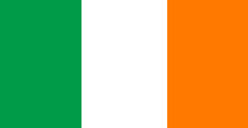

and they strive persistently to associate irrationality and want of balance with the term.
They evidently want the world to believe that anyone who opposes Jewish pretensions is more or less mentally deranged.'
--Denis Fahey
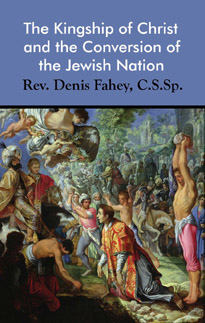
or in those of the money manipulators. He knows that, given fallen human nature,
this will lead to the subordination of men to production of material goods and to the treatment of all those not in power as mere individuals, not as persons.
For this, he favored Liberalism or Individualism and now favors the reaction against Individualism — Collectivism and Communism.'
--Denis Fahey
by Father Fahey:
A mediocre man, even a good one, is soon forgotten.
But if he was a great man and he had a profound influence for good,
his enemies will use every opportunity to desecrate his grave and distort his legacy long after he is gone.
Fr. Denis Fahey was such a great man.
Although he died in 1954, his works have become more significant with each passing year.
As the world plunges further and further into a satanic darkness...'
--catholicism.org/catholic-world-of-fahey.html

(whose radio persona was 'Joe Scanlon')
(whose radio personas were 'BBB' and 'Mr. Guess Who?)
(whose radio persona was 'Paul Revere')
(whose radio personas were 'Tokyo Rose', and sometimes 'Orphan Ann'. Toguri took part in a show called 'The Zero Hour')
(whose radio personas were 'Mr. OK' (from his initials) and Doctor Anders. He did a radio show called 'O.K. Speaking')
(Ezra Pound broadcasted hundreds of radio shows out of Italy)
(Kaltenbach did a show called 'Letters to Iowa' and also did a radio show with another American, Max Otto Koischwitz, called 'Jim and Johnny')
(whose radio personas were 'Sally' or 'Axis Sally', she did a program called 'Jerry's Front Calling' or simply 'Jerry's Front'.
Rita worked for the Italians first and later the Germans)
(by far the most famous of the group, whose radio personas were 'Midge at the Mike' or more famously 'Axis Sally'. She did a show called Home Sweet Home, among others.)
[Work in progress!]
(whose radio persona was 'E. D. Ward')
[Work in progress!]
(whose radio persona was 'Georgia Peach')
[Work in progress!]
[Work in progress!]






Senza Senza
Fame Tempo'
(Earth Country
Without Without
Hunger Time).
because few have been able to visit and study it freely. This book allows us to enter it,
to peer into the intimacy of its life, with the guidance of an intelligent and sincere interpreter.
From the fabulous antiquity of its origins and the constancy of sleepy traditions
to today's reality of its inhabitants, customs, crops, religious and erotic superstitions, Schrenzel paints,
with admirable confidence and evidence, the strange country still shrouded in an atmosphere of unexplored promise.
And his testimony as a traveler and scholar acquires in our eyes a special merit,
for not being dominated by preconceptions but inspired by disinterested and rigorous objectivity.']




First solo flight by a woman from North to South America.
First solo flight around South America by man or woman.
First complete flight by a land plane around South America by a man or woman.
First American woman to fly the Andes solo.



[...]
Was die Welt funkt hör mit BLAUPUNKT'
[...]
Listen to what the world is doing with BLAUPUNKT)]
Aus seinem Rechenbuch, Seite 3
Es gibt in Deutschland mindestens 30 Millionen Ofen und Herde, die durch "Nebenluft"
infolge undichter Türen, Kacheln, Rauchrohre am Tag 0,8 Kohle zuviel verbrauchen.
Gewinn für ihn?
Frage: 1. Wie viele Bergmannarbeitsstunden werden im Monat durch "Nebenluft" der 30 Millionen versaubeutelt, wenn ein
Bergmann in 8 Std. 1600 kg Kohle
fördert?
2. Wie viele Panzer könnten in dieser
Zeit gebaut werden, wenn in einem
Panzer 12000 Arbeitsstunden stecken?.'
Also "Nebenluft" Heute Noch Überall Abstellen!'
From his arithmetic book, page 3
There are at least 30 million stoves in Germany that are heated by "secondary air"
as a result of leaking doors, tiles, smoke pipes, consume 0.8 coal too much per day.
Gain for him?
Question: 1. How many miners' working hours are wasted per month by the "secondary air" of the 30 million, if a
miner in 8 hours produces 1600 kg of coal?
2. How many tanks could be used in this
time when one tank
uses 12000 hours of work?'
So turn off "secondary air" everywhere today!)]
Kohlenklau!
Verderbt dem Kohlenklau den Spaß
und spart mit Kohle, Strom und Gas'
the coal thief!
Spoil the coal thief's fun
and save on coal, electricity and gas)








--White Man, Think Again!, Introduction to the 2017 edition, pg. 9








They will take Africa from the British and give it to the Africans who deserve to have it."

'Along with Elijah Muhammad, Jordan was among the most prominent of the pro-Tokyo spokesmen in the United States; certainly he was the most prominent of this group in Harlem. The FBI reported that while toiling for the aforementioned Japanese shipping company and residing in Japan he "found the Japanese to be very friendly to the Negroes and that he had the privilege of studying the customs of the Japanese and becoming a member of... society in Japan.
[Tokyo Bound: African Americans and Japan Confront White Supremacy, Gerald Horne]
[Playing Changes: Music as Mediator between Japanese and
Black Americans, E. Taylor Atkins]
'enlightened Negro leaders" had told them 'that between and eighty and ninety percent of the American colored population who had any views on the subject at all, are pro-Japanese...'
[Tokyo Bound: African Americans and Japan Confront White Supremacy, Gerald Horne]
'numerous complaints have been received that the American Negroes favor a Japanese victory in the present war.'
[British Prime Minister Winston Churchill (1874-1965), speaking to Lord Robert Boothby]
[The Nation, Harlem at War, pg. 86, by Charles Williams]
'Overt conduct, such as speech or organization, that tends toward rebellion against the established order.'









It was, I venture to suggest, this semi-occult power which... pushed the mass of the American people into the cauldron of World War I."

[War made new: technology, warfare, and the course of history, 1500 to today, Max Boot.]
[Operation Sealion: How Britain Crushed the German War Machine's Dreams of Invasion in 1940, John Murray.]
'Crowley was a genuine avatar, but I don't think he knew it, but I do think he senses it in an emotional way.'
-Aleister Crowley


-|-
Third Reich Philatelia
-|-
-|-
Third Reich Ephemera
-|-
-|-
Third Reich Awards
-|-
-|-
Third Reich Miscellanea
-|-
-|-
Third Reich Identification Books
-|-
-|-
Third Reich Currency
-|-
-|-
The Great War
-|-
-|-
Hand of Pandora
-|-
-|-
Waffen-SS Technical Information -|-
-|-
The European Volunteer Movement in WWII -|-
-|-
Copyright -|-






